Matador Network's Blog, page 58
March 25, 2025
Budget Glamping in the US: 11 Luxe Retreats for Less Than $200
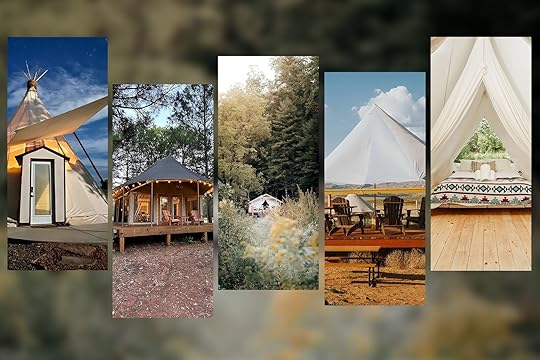
The call of the wild doesn’t have to mean roughing it. Across the US, there’s a nice selection of glamping sites that range from luxe set-ups for those who want to tip-toe into camping to more remote rustic sites, more suitable for camping aficionados who don’t want to lug a ton of gear with them on an outdoor trip (or have kiddos in tow). These drive-in setups have everything good to go, with facilities such as showers, toilets, and small kitchenettes — some even have separate rooms. From a treehouse-style safari tent in Arkansas’s Ouachita Mountains, a creekside retreat in Northern California to a stargazing tent with a clear ceiling near Utah’s Canyonlands National Park, these are the best glamping Airbnbs in the US under $200 per night.
We hope you love the glamping Airbnbs we recommend! Just so you know, Matador may collect a small commission from the links on this page if you decide to book a stay. Listed prices are accurate as of the time of publication.
Treehouse-style safari tent in the Ouachita Mountains, Arkansas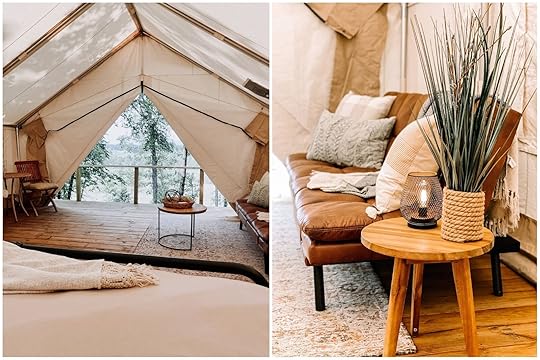 Photo: Airbnb
Photo: Airbnb Photo: Airbnb
Photo: Airbnb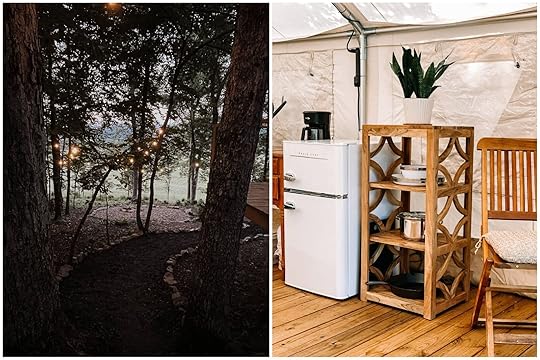 Photo: AirbnbSee more photos
Photo: AirbnbSee more photosThis beautiful glamping setup is near Mena, the gateway to the Ouachita National Forest. The area is known for its unhurried pace, with trails that wind through the hills and roads that invite road trips. The Little Missouri Falls is a short distance away for a swim, and the Talimena Scenic Drive offers views stretching across the landscape. The tent sits within a private 27-acre spread in the Ouachita Mountains. It’s climate-controlled, and the bed has a memory foam mattress. There’s a small fridge and a coffee maker, enough for the basics, and an outlet for charging devices. Outside, a grill and fire pit means you can cook evening meals under the open sky, and a hammock offers a spot to watch the forest change with the light.
Five guests, one bedroom
Price: $129 per night
 Photo: Airbnb
Photo: Airbnb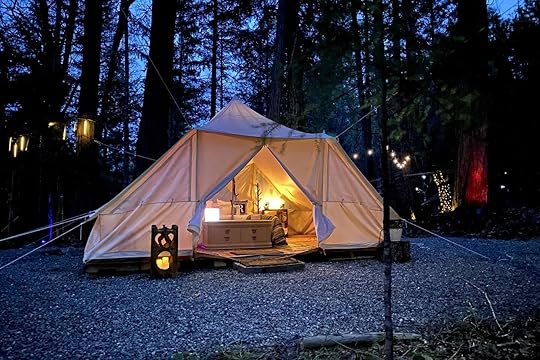 Photo: Airbnb
Photo: Airbnb Photo: Airbnb
Photo: Airbnb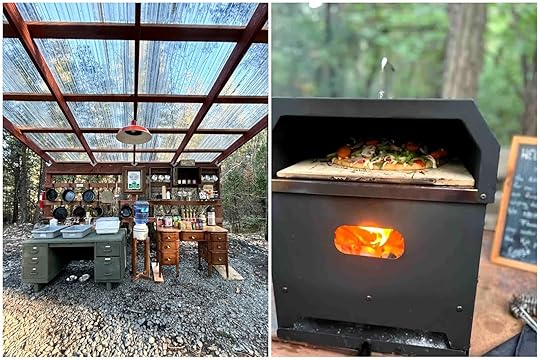 Photo: AirbnbSee more photos
Photo: AirbnbSee more photosIn the forested outskirts of Burnt Ranch, Northern California, this creekside glamping retreat is a getaway is ideal for those who want to connect with nature. The canvas tent, shaded by mature trees, accommodates two or three guests. There’s a king-sized memory foam bed, and an extra twin bed can be added if you have a third guest. The host has added thoughtful touches like local guides, books, and cooking essentials, and there’s an outdoor clawfoot tub surrounded by a living wall for bathing under the stars. Guests share the 30-acre space with a maximum of twelve others (more glamping accommodations are available), and communal fire pits and seating areas are scattered throughout the property.
Three guests, one bedroom
Price: $177 per night
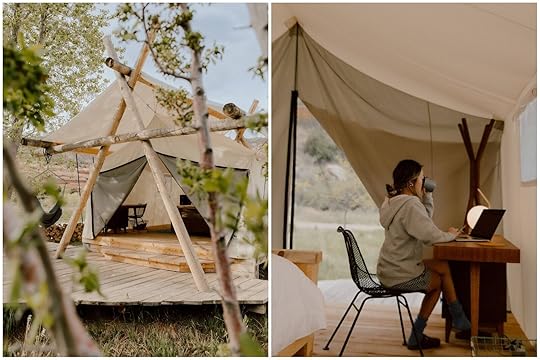 Photo: Airbnb
Photo: Airbnb Photo: Airbnb
Photo: Airbnb Photo: Airbnb
Photo: Airbnb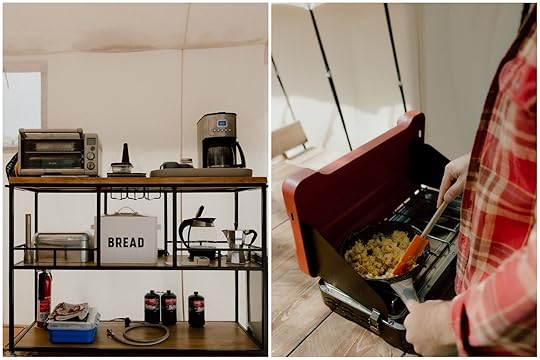 Photo: AirbnbSee more photos
Photo: AirbnbSee more photosIf you’re glamping with a group, this top one percent glamping Airbnb is ideal, especially if you’re into hiking. Situated near Mesa Verde, the two safari tents are set within a young orchard in Cortez, Colorado. The canvas structures, each with a king bed and their own lounging space, have a stunning view of the Canyon of the Ancients. They share a large dining area with a Coleman stove and propane fire pit. A separate bathhouse has indoor and outdoor showers, two sinks, and toilets. The property, spanning 38 acres, includes a hay farm, cliffside trails, and a section of McElmo Creek. Guests have access to most of the land, with a request to avoid the marked private residence.
Four guests, two bedrooms
Price: $158 per night
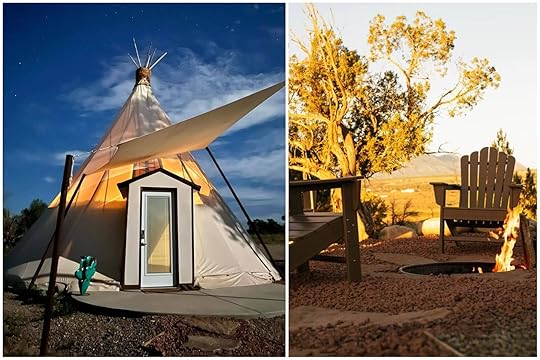 Photo: Airbnb
Photo: Airbnb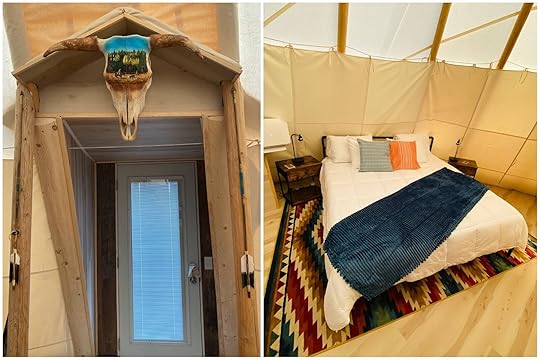 Photo: Airbnb
Photo: Airbnb Photo: AirbnbSee more photos
Photo: AirbnbSee more photosAnother option near Mesa Verde is this two-bed glamping tipi just outside of Cortez. It’s situated on a family farm where deer and elk roam freely. The tipi is a 500-year-old Native dwelling, but the owners have transformed it into a modern stay with a full kitchen and an indoor, yes, an indoor private bathroom.
Four guests, one bedroom
Price: $165 per night
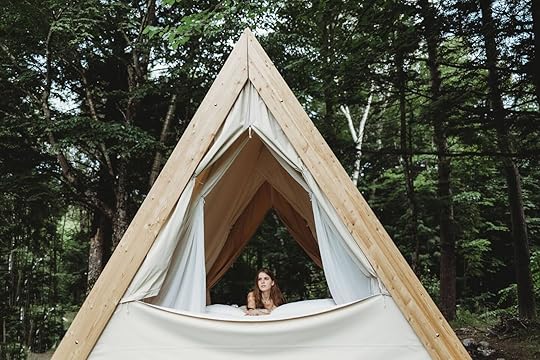 Photo: Airbnb
Photo: Airbnb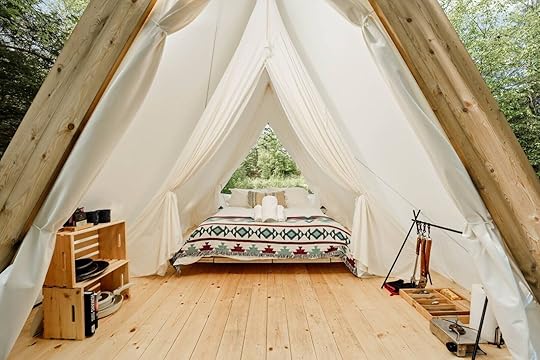 Photo: Airbnb
Photo: Airbnb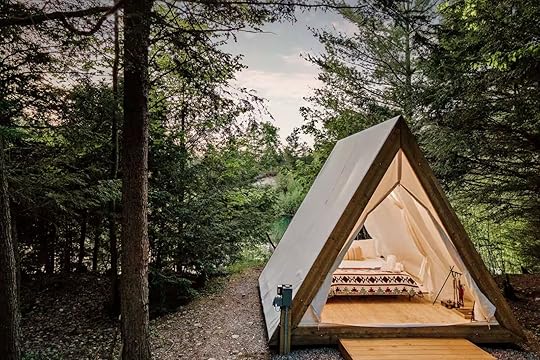 Photo: Airbnb
Photo: Airbnb Photo: AirbnbSee more photos
Photo: AirbnbSee more photosPerfect for a couples getaway, this A-frame tent is tucked into the woods near Woodstock. There’s no clutter. It’s minimalist, with a queen-sized bed, a fire pit, gas stoves, Adirondack chairs looking over a pond, a hammock, and a picnic table. The structure has beautiful styling, and you won’t be roughing it. A short walk away, you’ll find a bathhouse with hot showers. Surrounded by the White Mountains, with plenty of hiking trails and natural scenery, the area offers a mix of quiet and access to outdoor activities.
Two guests, one bedroom
Price: $128 per night
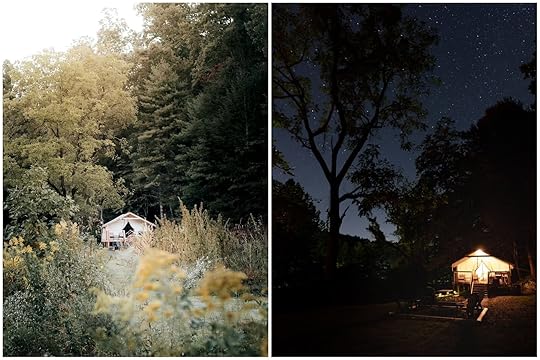 Photo: Airbnb
Photo: Airbnb Photo: Airbnb
Photo: Airbnb Photo: Airbnb
Photo: Airbnb Photo: AirbnbSee more photos
Photo: AirbnbSee more photosIf you’re looking for solitude, this charming tent is surrounded by Pisgah National Forest in the foothills of the beautiful Southern Appalachian Mountains. There’s no WiFi or electricity, so be prepared to be off-grid. It’s situated on a family farm and offers all the comforts of home with an indoor wood stove, a queen-sized bed (with a futon sleeper couch for extra sleeping space), an outdoor hot shower, a covered kitchen porch, and a fit pit area.
Four guests, one bedroom
Price: $109 per night
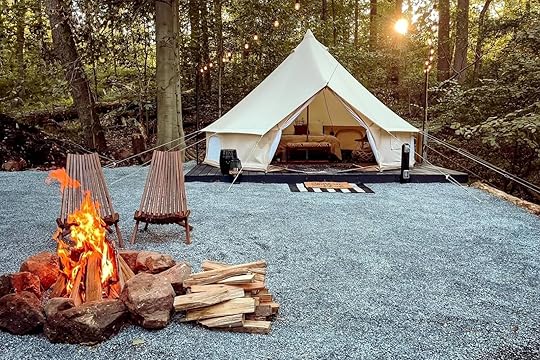 Photo: Airbnb
Photo: Airbnb Photo: Airbnb
Photo: Airbnb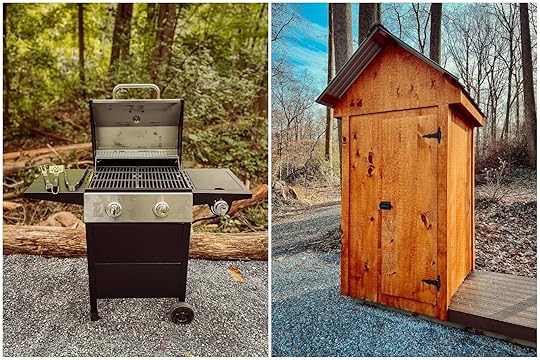 Photo: Airbnb
Photo: AirbnbIf you’re looking for luxury glamping, this site is the perfect fit. The super comfortable queen bed has a heated blanket and an electric fire for chilly evenings. The shower house (a two-minute walk away) has complimentary toiletries, towels, and a handy bath caddy. The site is nestled in the woods in Lancaster County near Denver in a private area of campgrounds — so expect neighbors. Guests are welcome to use all the campground has to offer, including laundry and a loveseat swing. An on-site store also sells ice cream, drinks, and other camping-related items.
See more photos
Two guests, one bedroom
Price: $128 per night
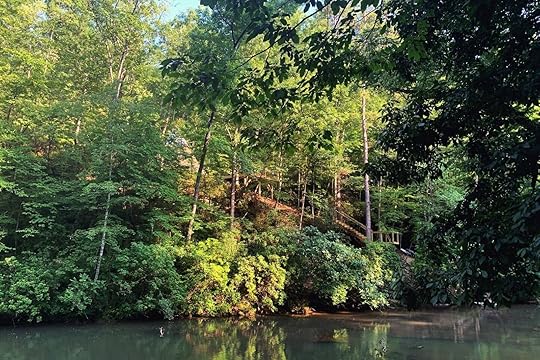 Photo: Airbnb
Photo: Airbnb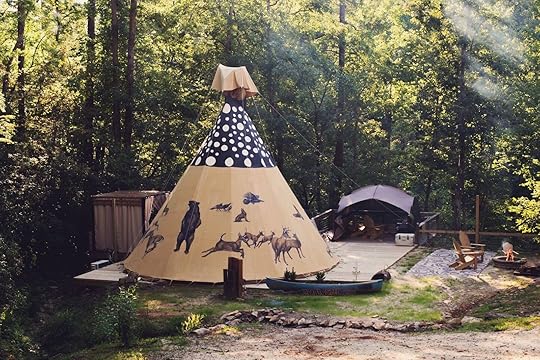 Photo: Airbnb
Photo: Airbnb Photo: AirbnbSee more photos
Photo: AirbnbSee more photosFor something with a little more character, check out this tipi named “Adawehi”. Adawehi means the spirit of healing in Cherokee. It’s in a secluded area on the Chauga River in Oconee County. You’ll need a four-wheel drive vehicle to access this remote setting, but that’s part of the experience. This is a place to reconnect with nature and escape the rush of everyday life. The large tipi has a queen-sized bed, a twin bed, and a convertible couch. For entertainment, there’s plenty to do outdoors, and the host kindly provides board games, a DVD player, and a projector with a selection of Native-American-themed movies. Cooking facilities are outdoors, but this includes a mini-air fryer because who wants to camp without homemade fries?
Five guests, one bedroom
Price: $171 per night
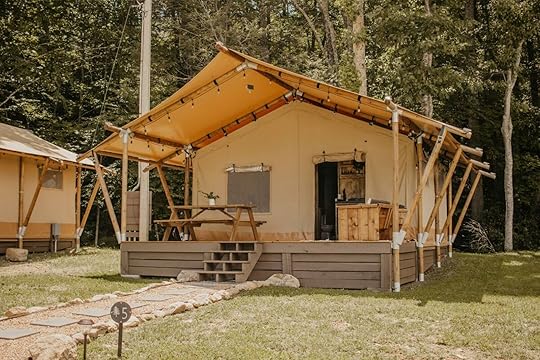 Photo: Airbnb
Photo: Airbnb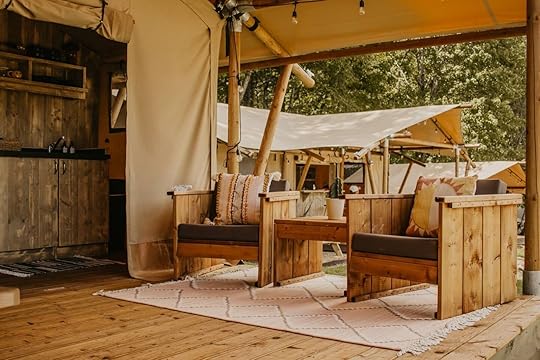 Photo: Airbnb
Photo: Airbnb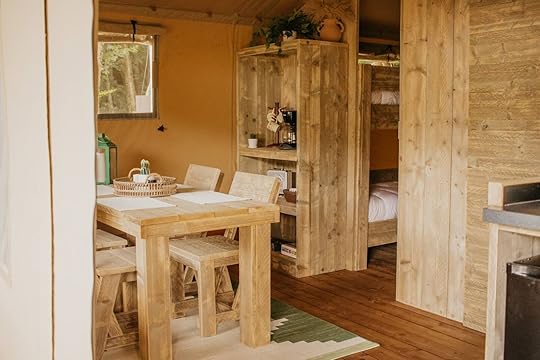 Photo: Airbnb
Photo: Airbnb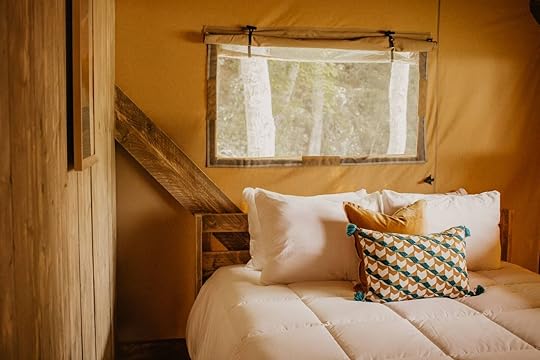 Photo: AirbnbSee more photos
Photo: AirbnbSee more photosAnother option on a professionally run campsite is this stunning two-bedroom glamping tent. Ideal for those traveling with kids, the separate bedrooms include a queen bed and a twin bunk bed in the other. The kitchen has a mini fridge, an electric burner, sink, and coffee bar. This is one of nine rental units on the 16-acre site, which borders the Tennessee and North Carolina state lines and the Pisgah National Forest. There’s no roughing it here. The site has four luxurious bathhouses with walk-in showers, a communal pavilion with outdoor couches, tables, a selection of games, and a fire pit.
Four guests, two bedrooms
Price: $155 per night
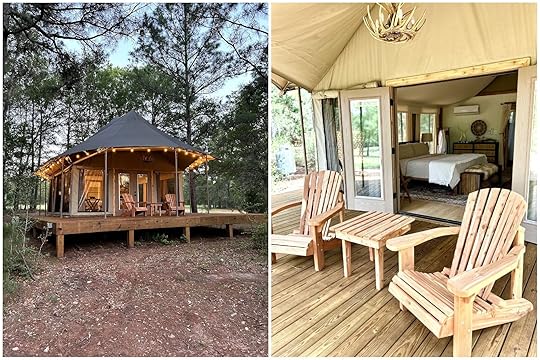 Photo: Airbnb
Photo: Airbnb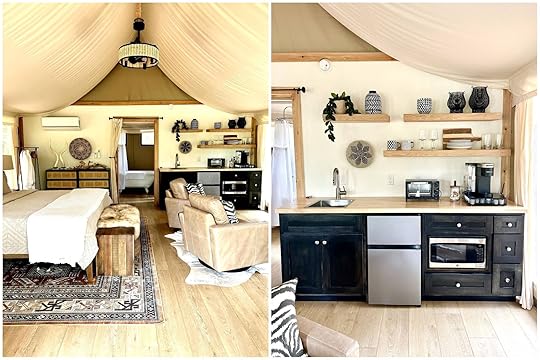 Photo: Airbnb
Photo: Airbnb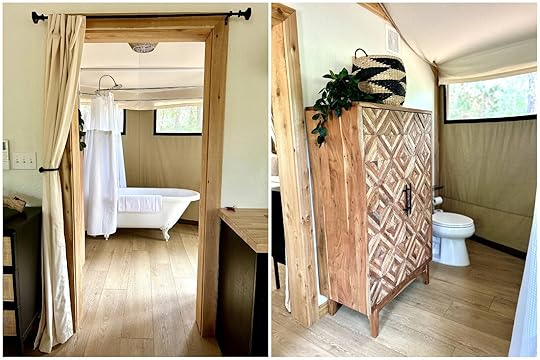 Photo: AirbnbSee more photos
Photo: AirbnbSee more photosA climate control system, a claw foot bathtub, a king-sized bed, plush furnishings, a TV, and a full kitchen setup make this glamping tent the closest thing to a hotel stay I’ve ever seen. Around 20 minutes from Round Top, Texas, this super luxurious tent even has complimentary bathrobes and a walled-off opulent safari lodge-style bathroom. If you want to tip-toe into camping and you’re not quite ready for the full-blown experience of sleeping outdoors, this is the perfect place to start.
Two guests, one bedroom
Price: $200 per night
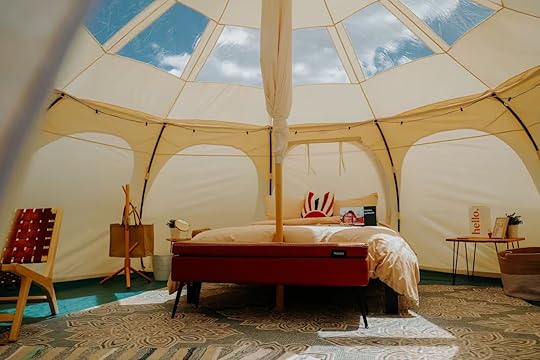 Photo: Airbnb
Photo: Airbnb Photo: Airbnb
Photo: Airbnb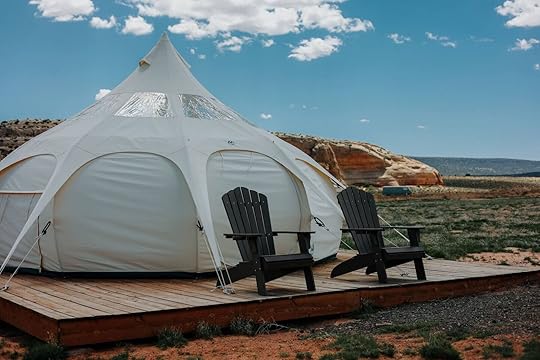 Photo: Airbnb
Photo: Airbnb Photo: AirbnbSee more photos
Photo: AirbnbSee more photosThis glamping Airbnb was built for stargazing. There’s a clear ceiling, so you can lie in bed and watch the night sky. Outside has a nice setup with a deck, hammocks, a picnic table, and a fire pit. The eco-friendly glamping site runs on solar power (there are also battery packs to keep your phones charged), and they have a recycling and composting program. If you are interested in the night sky, you can book an astronomy tour run by the campsite, and there’s a sauna and WiFi available in the main communal spaces. Monticello is a good base for exploring the area. It’s quiet and rural, about 40 minutes from Moab and the Needles District of Canyonlands National Park. 
Two guests, one bedroom
Price: $163 per night
March 24, 2025
Matador Editors Broke Travel Photography Down to Five Specific Use Cases. Here’s the Best Camera for Each.
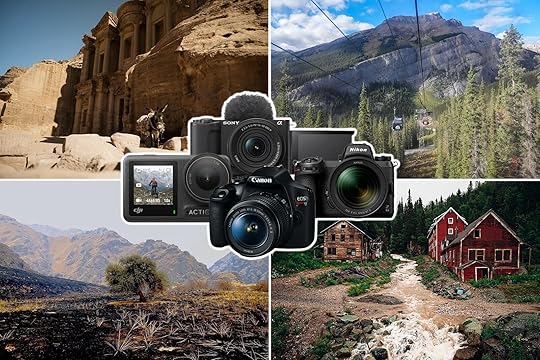
Photographs capture the essence of travel in a manner that other forms of storytelling simply can’t do. Locking the action or emotion of a moment into a still shot can be the best way to birth the nostalgic romance that keeps you yearning for their next trip. Making this perfect photo takes timing, the right equipment, and often, a bit of luck – and having the right travel camera can make all the difference. Matador staffers and contributors spend months on the road each year, living the stories that fill the site with inspiration, aspiration, and the trip planning knowledge necessary to act on both. These are the cameras they bring with them, based on the performance in following use cases:
Lightweight and portableLandscape and wide shotsMirrorlessLow-lightVideo action and stillsWe hope you love these travel cameras! Just so you know, Matador may collect a small commission from the links on this page if you decide to make a purchase.
Things to consider when choosing a travel cameraBeyond your specific use case(s), you’ll want to consider certain specifics when choosing a travel camera.
Size and portabilityBeyond your specific use case, you’ll want to consider certain specifics when choosing a travel camera. Travel cameras should be lightweight and easy to carry. Bulky DSLRs can be cumbersome if you’re not on a professional assignment, whereas compact mirrorless or point-and-shoot cameras offer a great mix of quality and convenience. Consider the size of the camera and whether it fits easily in your bag or pocket.
Image quality and sensor sizeA larger sensor generally means better image quality, especially in low-light conditions. Full-frame and APS-C sensors deliver stunning detail but tend to be larger, while 1-inch and Micro Four Thirds sensors balance portability and quality.
Lens options and zoom capabilityConsider whether you want a fixed-lens camera (like premium compact cameras) or one with interchangeable lenses (like mirrorless or DSLR models). If you need zoom for wildlife or landscapes, a versatile zoom lens (e.g., 24-200mm) can be beneficial.
Megapixels and resolutionWhile higher megapixels allow for more detailed images, anything above 18MP is generally sufficient for travel photography. More megapixels help when cropping photos, but they aren’t the only factor in image quality—sensor size and lens quality matter more.
Autofocus and performanceFast and accurate autofocus ensures you capture sharp images on the go. You can even find a camera with AI-powered subject tracking like the DJI Osmo Action 4 for moving subjects like people, wildlife, and vehicles. A high burst rate (frames per second) is also useful for action shots.
Battery life and charging optionsTraveling means long days of shooting, so battery life is crucial. Some cameras offer USB-C charging, allowing you to charge via a power bank—perfect for travel. Carrying spare batteries is always a smart move.
Low-light performance and flashIf you plan to shoot at night or indoors, look for a camera with a wide aperture lens (f/2.8 or lower) and good ISO performance. Built-in flashes can be harsh, so an external flash or long-exposure settings might be better for capturing nighttime scenes.
Viewfinder vs. LCD screenA viewfinder (optical or electronic) helps in bright sunlight, making it easier to compose shots. Many mirrorless cameras feature electronic viewfinders (EVFs), while compact cameras rely on LCD screens, which can be hard to see in bright outdoor conditions.
Video capabilitiesIf you love capturing videos, check for 4K resolution, frame rates (60fps or higher), and in-body stabilization to ensure smooth footage. Some cameras also support log profiles for color grading and external microphone inputs for better audio.
Budget and accessoriesCameras range from budget-friendly to professional-grade. Consider what fits your needs and budget. Remember to factor in accessories like:
Memory cards (fast write speed for 4K video). Matador photo editor Rulo Luna Ramos recommends the CFExpress Type B cardsCamera bag for protection. Ramos recommends the Lowepro Flipside 400Tripods for stability. Ramos uses the Manfrotto Befree Live 4-Section Carbon Fiber Video Tripod with Fluid HeadFilters (polarizing, ND) for creative shotsCanon EOS Rebel T7, T8i, or T6 – best travel DSLR camera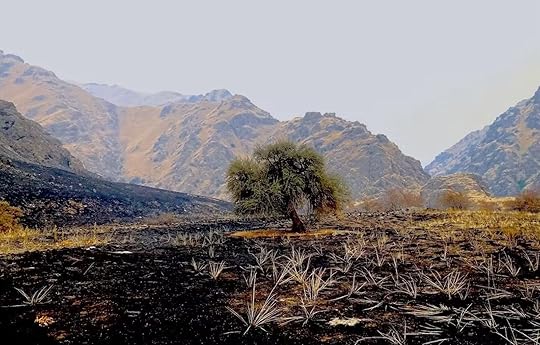 The Cliff Mountain Fire devasted the landscape around Hell's Canyon, in Idaho, in 2021. I captured this image just above the confluence of the Salmon and Snake Rivers on a four-day expedition through the area just after the fire. Photo: Tim Wenger
The Cliff Mountain Fire devasted the landscape around Hell's Canyon, in Idaho, in 2021. I captured this image just above the confluence of the Salmon and Snake Rivers on a four-day expedition through the area just after the fire. Photo: Tim Wenger Bootpacking to the summit of Chych peak in Kyrgyzstan, 2023. Photo: Tim Wenger
Bootpacking to the summit of Chych peak in Kyrgyzstan, 2023. Photo: Tim Wenger This seal rose to check us out as we slowly drifted by in a ducky. Inner Passage, Alaska, 2023. Photo: Tim Wenger
This seal rose to check us out as we slowly drifted by in a ducky. Inner Passage, Alaska, 2023. Photo: Tim Wenger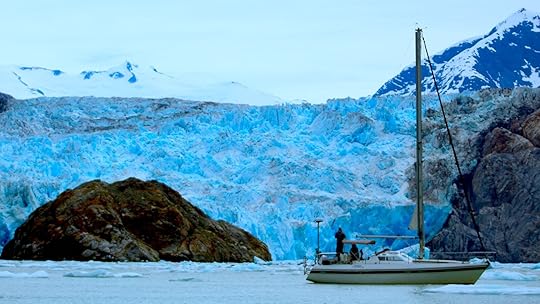 My first time seeing a real glacier. Inner Passage, Alaska, 2023. Photo: Tim Wenger
My first time seeing a real glacier. Inner Passage, Alaska, 2023. Photo: Tim WengerThe Canon EOS Rebel T Series helped transactional content editor Tim Wenger hone his photography chops to the point where he feels confident about shooting photos to accompany his written work. According to Wenger, the camera stands out as the ideal DSLR for travel photographers looking for a perfect balance between performance, portability, and affordability. With models like the T7i and T8i, you get a 24.1MP APS-C CMOS sensor, fast and accurate Dual Pixel autofocus, and built-in Wi-Fi and Bluetooth for easy sharing on the go. Its intuitive interface and guided mode make it beginner-friendly, while the impressive image quality and versatile shooting options satisfy more experienced users. The lightweight build also means it won’t weigh you down when you’re exploring new destinations. The T6 was the camera that got him hooked on the Rebel series nearly a decade ago, and newer models have only solidified that opinion.
What truly makes the Rebel T Series the best DSLR travel camera is its reliability and flexibility in a wide range of environments. Whether you’re capturing bustling street scenes, serene landscapes, or spontaneous portraits, this camera delivers consistently sharp, vibrant shots. The articulating touchscreen and solid battery life further enhance usability, while Canon’s extensive lens ecosystem opens up creative possibilities without needing to switch systems. For travelers wanting a durable, user-friendly DSLR that doesn’t compromise on quality, the Rebel T Series checks every box.
Check out Matador’s full review of the Canon EOS Rebel series
Sony Alpha ZV-E10 II – best compact travel camera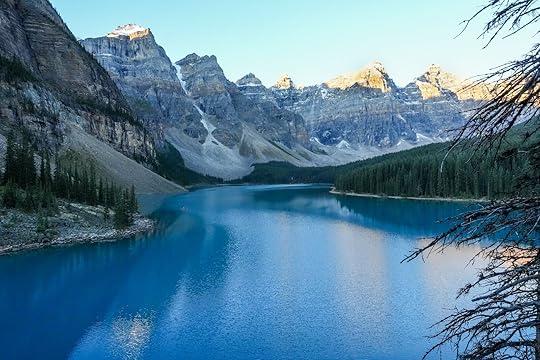 Moraine Lake. Photo: Lauren Breedlove, taken with Sony Alpha ZV-E10 II
Moraine Lake. Photo: Lauren Breedlove, taken with Sony Alpha ZV-E10 II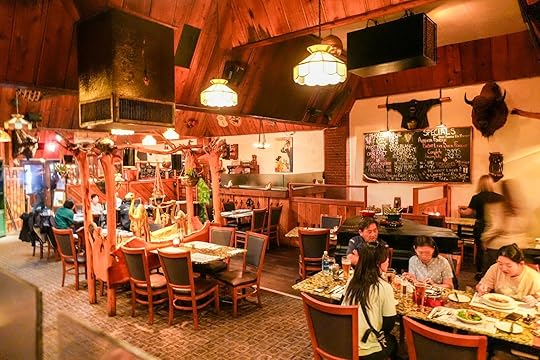 The camera takes shots equally impressive indoors. Photo: Lauren Breedlove, taken with Sony Alpha ZV-E10 II
The camera takes shots equally impressive indoors. Photo: Lauren Breedlove, taken with Sony Alpha ZV-E10 II Sunshine Village gondola. Photo: Lauren Breedlove, taken with Sony Alpha ZV-E10 II
Sunshine Village gondola. Photo: Lauren Breedlove, taken with Sony Alpha ZV-E10 II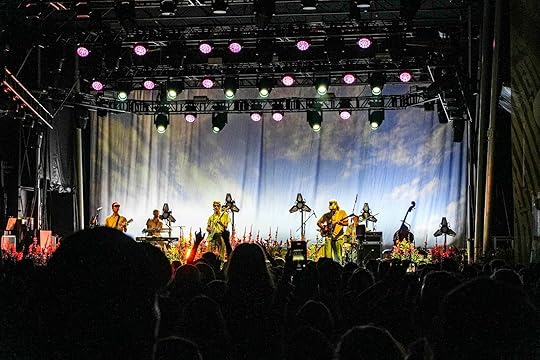 Borderland Music + Arts Festival. Photo: Lauren Breedlove, taken with Sony Alpha ZV-E10 II
Borderland Music + Arts Festival. Photo: Lauren Breedlove, taken with Sony Alpha ZV-E10 II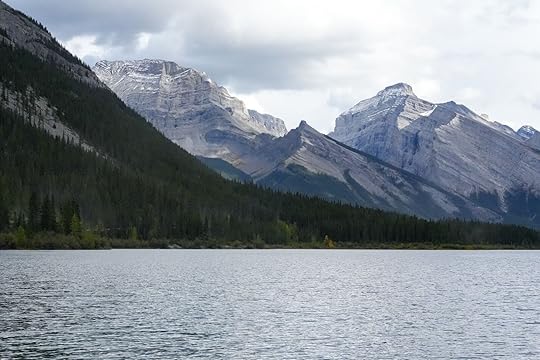 Banff National Park in all her glory. Photo: Lauren Breedlove with the Sony Alpha ZV-E10 II
Banff National Park in all her glory. Photo: Lauren Breedlove with the Sony Alpha ZV-E10 IIThe Sony Alpha ZV-E10 is a game-changer for travelers who want pro-level content creation in a compact, lightweight package. Designed with vloggers and on-the-go creators, it features a 24.2MP APS-C sensor, fast hybrid autofocus, and a fully articulating touchscreen that makes capturing high-quality video and stills effortless. Its dedicated microphone port, wind screen, and advanced audio features ensure crisp, clear sound—no external mic required. Plus, with one-touch background defocus and Product Showcase mode, it’s tailored for dynamic, cinematic storytelling anywhere your travels take you. Travel journalist and Matador contributor Lauren Breedlove stands firm on this being the best compact travel camera.
What makes the ZV-E10 the best compact travel camera is its versatility packed into such a small body. You get the benefits of an interchangeable lens system without the bulk of a traditional DSLR, and its USB-C charging and live streaming capabilities mean you’re always ready to create, connect, and share on the fly. Whether you’re documenting epic landscapes or daily travel vlogs, the ZV-E10 combines pro-level quality with ultimate convenience—making it a must-have for modern content creators.
Check out Matador’s full review of the Sony Alpha ZV-E10 II
Sony A7 IV – best mirrorless digital travel camera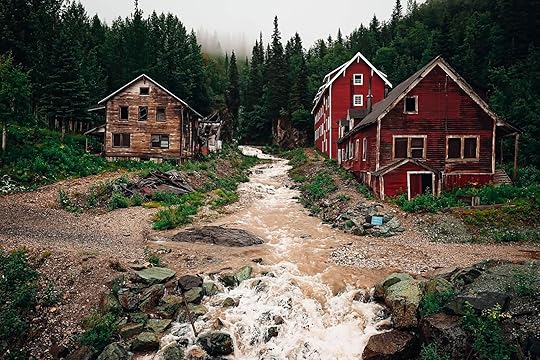 The colors are excellently highlighted, even in less-than-optimal lighting. Photo: Suzie Dundas
The colors are excellently highlighted, even in less-than-optimal lighting. Photo: Suzie Dundas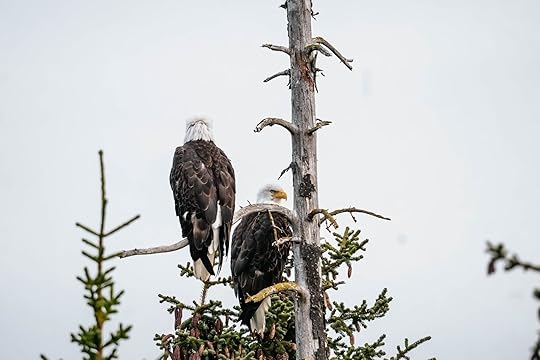 Wildlife shots are sharp. Photo: Suzie Dundas
Wildlife shots are sharp. Photo: Suzie Dundas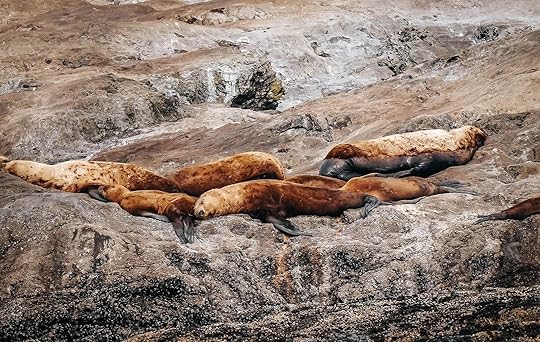 It was easier to tell the seals from the rock in the photo than IRL. Photo: Suzie Dundas
It was easier to tell the seals from the rock in the photo than IRL. Photo: Suzie Dundas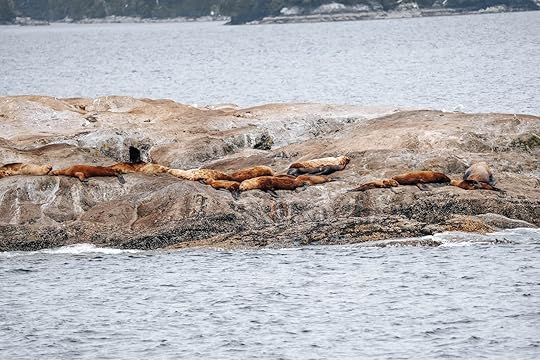 I loved how crisp this photo came out, despite the lack of natural contrast. Photo: Suzie Dundas
I loved how crisp this photo came out, despite the lack of natural contrast. Photo: Suzie Dundas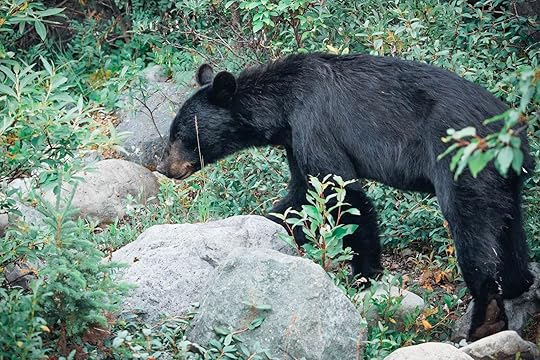 It appears so much closer than it actually was. Photo: Suzie Dundas
It appears so much closer than it actually was. Photo: Suzie DundasThe Sony A7 IV sets a new standard for hybrid shooters, making it the ultimate full-frame travel camera for those who demand top-tier performance in both photography and video. Matador commissioning editor Suzie Dundas carries the camera with her as its proved to be the best mirrorless camera she’s tried. With a powerful 33MP full-frame sensor, lightning-fast autofocus with real-time subject tracking, and 4K video at up to 60fps, this mirrorless marvel delivers professional-quality results in virtually any shooting scenario. Its redesigned body offers improved handling, a sharper vari-angle LCD touchscreen, and dual card slots—ideal for fast-paced travel days.
What makes the A7 IV unbeatable for travel is its perfect blend of power and portability. Despite its robust capabilities, it remains compact enough for carry-on gear, yet durable enough for rugged adventures. The in-body image stabilization, customizable controls, and long battery life provide peace of mind on the move, while the deep menu system and creative modes cater to both pros and serious travelers who are willing to drop some dime on a mirrorless camera for travel (it runs just under $2,500 on Amazon).
Check out Matador’s full review of the Sony A7 IV
Nikon Z6 III – best low-light travel camera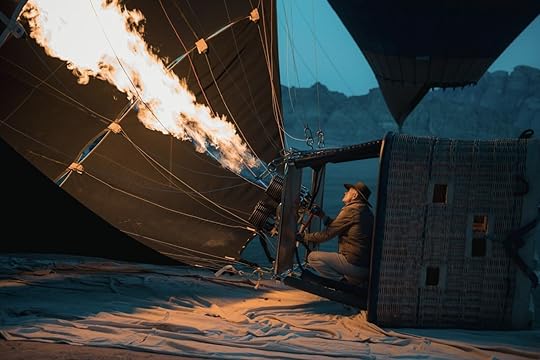 Even when action is only part of the shot, the entire image is crisp. Photo: Rick Southers
Even when action is only part of the shot, the entire image is crisp. Photo: Rick Southers Consistency across a shoot is imperative. Photos: Rick Southers
Consistency across a shoot is imperative. Photos: Rick Southers Low-light photography is a standout feature of the camera. Photos: Rick Southers
Low-light photography is a standout feature of the camera. Photos: Rick Southers The image looks as clean as the setting. Photo: Rick Southers
The image looks as clean as the setting. Photo: Rick SouthersBoth the Nikon Z6 III and the Sony A7 IV are full-frame mirrorless cameras, but Matador staffers have found different advantages to each. Matador video producer Rick Southers was blown away by the The Nikon Z6 III as a full-frame mirrorless camera that excels in both performance and portability. Building on the strengths of its predecessor, the Z6 III features a 24.5MP BSI (backside-illuminated) sensor that delivers stunning image quality, especially in challenging lighting conditions. Its low-light performance is one of its standout features—producing clean, detailed images at higher ISOs, which is a major advantage for capturing dimly lit interiors, night scenes, or early morning landscapes. With improved autofocus, in-body image stabilization, and a fast burst rate, the Z6 III adapts easily to a wide range of shooting scenarios, from street photography to fast-moving subjects.
What makes the Z6 III particularly appealing for travelers is its ergonomic design, weather-sealed build, and long battery life—essentials for long days of shooting in unpredictable environments. The camera is compact enough to pack easily without sacrificing the feel of a pro-level tool in hand. Its high-quality EVF, intuitive controls, and compatibility with Nikon’s growing Z-mount lens lineup offer flexibility on the go. Whether you’re documenting a remote hike, shooting golden hour in a city, or filming travel content, the Z6 III offers the performance, durability, and low-light reliability that make it a top-tier travel companion.
Check out Matador’s full review of the Nikon Z6 III
DJI Osmo Action 4: Best video action camera A shot captured with this contrast, angle, and detail could only happen on a cation camera - and only on the DJI Osmo Action 4. Photo: Scott Sporleder
A shot captured with this contrast, angle, and detail could only happen on a cation camera - and only on the DJI Osmo Action 4. Photo: Scott Sporleder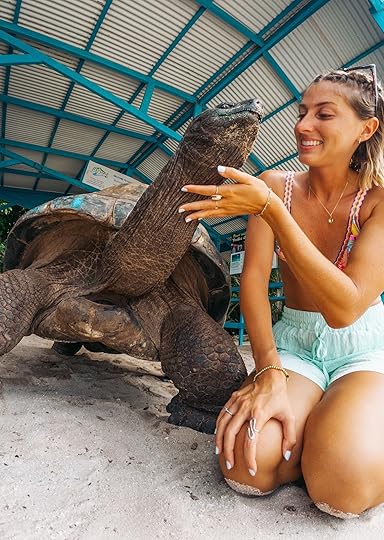 Crisp detail and vivid colors stand out with the DJI Osmo Action 4. Photo: Scott Sporleder
Crisp detail and vivid colors stand out with the DJI Osmo Action 4. Photo: Scott Sporleder The difference in colors between this image and the next shows the versatility of the camera. Photo: Scott Sporleder
The difference in colors between this image and the next shows the versatility of the camera. Photo: Scott Sporleder The Burj Khalifa looks equally intimidating, however. Photo: Scott Sporleder
The Burj Khalifa looks equally intimidating, however. Photo: Scott SporlederThe DJI Osmo Action 4 raises the bar for travel-ready action cameras, offering exceptional image quality, rugged road hardiness, and pro-level features in a compact body. Matador creative director Scott Sporleder has traveled the world with his and used it underwater, above ground, and everywhere inbetween. It’s built around a 1/1.3-inch sensor with wide dynamic range, making it ideal for capturing vivid detail in both bright sunlight and low-light environments—perfect for everything from underwater dives to dusky mountain trails. With RockSteady 3.0+ stabilization and HorizonSteady, his footage stays smooth and level. He also appreciates the dual touchscreens, fast charging, and voice control.
What makes the Osmo Action 4 the best action travel camera is its seamless blend of power and portability. It’s waterproof up to about 59 feet (18 meters) without a case, cold-resistant, and built for the most rugged conditions travelers might encounter. The camera’s intuitive interface, long battery life, and advanced color profiles (including D-Log M) give creators the freedom to shoot cinematic footage anywhere. 
Check out Matador’s full review of the DJI Osmo Action 4
More like thisTravelThe Best Large Hardshell Luggage Options for Your Active Travel LifestyleAsk Matador: How to Land a Matador Creators Press Trip

Say you’re thumbing through gigs on Matador Creators and a press trip catches your eye. You want to apply, but you have questions: How do you know if your writing style is a good fit? What can you do to make your application stand out? Can you bring a plus-one on a press trip if their expenses aren’t covered?
In this Ask Matador column, the editor responsible for writer selection covers everything you need to know about landing press trips, from optimizing your application to navigating the feedback process. You asked. We’re answering. And we’re sprinkling in some extra tips for good measure. See you in the apps!
Getting chosen for press tripsHow do you decide who can go on a creator trip?We try to match writers whose experience, interests, or style best aligns with the trip at hand. We review every application and learn more about potential candidates by reading their portfolios, websites, blogs, etc. Beyond that, there’s no hard-and-fast rule for who can go on a creator trip. We like being a platform where new writers can get their first bylines as much as we like publishing stories from seasoned journalists or collaborating with creators who’ve delivered great work for us in the past.
What makes an application stand out?Applications are the first writing samples we see. We’re not looking for writers to wax poetic, but we do look for proper grammar and syntax, the ability to follow prompts clearly and concisely, and a little bit of personality.
Beyond that, sharing examples of past work is incredibly helpful, whether you link specific stories or your whole portfolio. If you haven’t been published yet, that’s okay too — let us know what other writing experience you have, why you’re interested in travel writing, and what ideas you have for the trip at hand. And don’t be afraid to let some of your writing style shine through!
One last tip: Apply using your full name (first and last).
What disqualifies an application?We consider every application, but there are tells that a creator might not be a good fit for a press trip with written deliverables. One example: using generative AI to craft your application. (We’re looking for writers, after all.) Another example: approaching your application like a resume, using the same language and framing you might lean on to land a job. (Again, we want to get a feel for your writing style.)
We also see trends that aren’t necessarily dealbreakers but aren’t doing prospective writers any favors, such as citing follower counts on social media or readership stats for your personal blog. It’s fine if most of your experience in the travel space comes from blogging or other types of content creation, but use your application as an opportunity to tell us how you plan to pivot that experience into more traditional travel journalism and capturing Matador‘s style and tone.
What type of content stands out in applications (ex: itinerary, story, format)?The best applications are usually pretty straightforward. They open with who you are as a writer and why you’re a good fit for the trip. They include links to sites or stories where we can learn more about you and your writing. And if you’ve got a great idea for a pitch, they can include that, too.
What are the qualities you look for in a creator?Professionalism is arguably the most important quality we look for in a creator. If you’re organized, responsible, responsive, easy to work with, and know how to meet your deadlines, chances are we’d love to work with you!
It’s also a good idea to familiarize yourself with Matador before applying. Whether or not you’ve written for us or even been published before, take the time to learn what types of stories we’re after and what type of voice we use to tell those stories.
Landing specific tripsHow can we make sure we’re a great fit for certain trips?If you have relevant experience for a specific trip — whether that’s personal ties to the destination, a love of birdwatching that aligns with the itinerary, or a sommelier certification that could come in handy — let us know. If not, tell us why the trip interests you and why you think you’re a great fit. One way to do that is to include a couple of brief pitches with your application. These thought-starters may not lead to the story that you end up writing, but they let us know that you’re already thinking about potential angles and how your perspective elevates them.
How do you decide between a writer who’s been to a specific location before versus one who’s newly exploring a destination?Sometimes, we’ll get a great pitch from a writer based on their familiarity with a destination. Other times, a writer will propose an angle that only works because they’ve never been. Both perspectives can yield excellent stories; neither is a guarantee or dealbreaker. There are a lot of factors that go into picking the best possible writer for any given press trip — writing background, hobbies, specialties, other relevant experience, etc — and whether or not you’ve been to the destination in question is rarely the deciding factor.
Do you prefer international or domestic creators?The host usually decides this based on what travel arrangements are feasible. If they have no preference, neither do we.
Navigating the feedback processWhy don’t we receive feedback when we aren’t selected for a trip?Due to the high volume of responses we get for creator trips, we’re not able to send personalized feedback to every applicant — as much as we’d like to!
I have experience and credentials but haven’t been selected — what and I doing wrong?There’s a very good chance you’re not doing anything wrong. We get a lot of applicants (and a lot of really great applicants) for every trip, and we’re only able to send one writer each time. Often, it’s a very close decision. The best thing to do in this situation is to keep applying. We take note when we see the same name pop up consistently, and we make a point to try to place those writers when the best possible fit for them comes around.
It’s worth noting that some opportunities (read: glitzy international press trips) get significantly more applicants than others. If you’re determined to get your foot in the door, make sure you’re applying for local or regional trips that probably have less competition (and therefore pave the way for your application to stand out).
Miscellaneous questionsCan my partner and I apply for a press trip as a writing team?Something we see fairly often that’s not positively impacting writer selection is two-person applications, such as husband-and-wife or writer-photographer duos. While plus-ones are often welcome to join individual trips — and can be credited for any photos they end up taking that get published as part of a story — we’re mostly looking to place one writer for each trip.
If a creator trip is on our radar but expenses aren’t included for plus-ones, can I still bring someone if we cover their expenses?In many cases, plus-ones are allowed to join individually hosted press trips provided they cover their expenses. It’s less common for plus-ones to be able to join group press trips even if they pay their way (although certain trips can accommodate this).
Our team will gather as much information as we can from trip hosts to include in our initial postings. For any outstanding questions about what’s allowed or covered, applicants are more than welcome to follow up with us or confirm with the host’s PR representative directly. 
31 Spring Music Festivals in the United States Worth Traveling For

From the sun-drenched beaches of California to Governors Island in New York Harbor, the spring 2025 music festival season in the United States offers more than just sound. As festivals evolve beyond simple lineups into immersive, multisensory experiences — something very much worth traveling for on an extended trip that includes more than just the music — this year’s landscape reflects the full spectrum of musical tastes and lifestyle interests.
While there are plenty of large concert tours worth traveling for this year, festival venues are about becoming part of the experience itself. In 2025, geography shapes atmosphere as much as sound: ski resorts, desert expanses, and historic sites add dimension to the experience. Bonnaroo’s 700-acre Tennessee site continues to cultivate its community-centric ethos, for example.
This emphasis on setting is no longer incidental, it’s part of the allure. Beyond the music, festivals are ever more connected to their host cities. Many thousands of people are drawn to the location itself to make a trip out of concert travel. The spring 2025 season illustrates one clear trend: music festivals are no longer just concerts — they’re cultural experiences defined by community, place, and intention.
April | May | JuneTwo Step Inn Festival
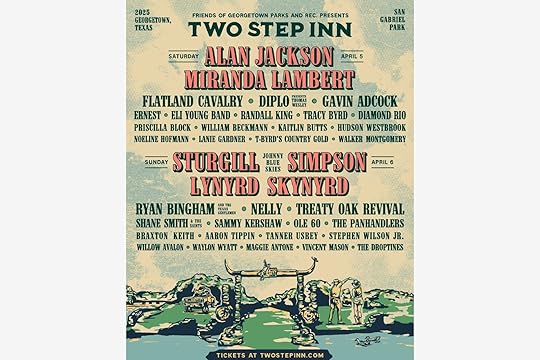
The Two Step Inn Festival brings a mix of country legends and Southern rock icons to the stage. The 2025 lineup features Alan Jackson, Miranda Lambert, Sturgill Simpson (as Johnny Blue Skies), and Lynyrd Skynyrd. With its laid-back Texas charm and top-tier talent, it’s a must for country fans.
Dreamville Festival

Dreamville Festival returns to Raleigh’s Dorothea Dix Park with a star-studded hip-hop lineup curated by J. Cole. This year’s headliners include Lil Wayne and the Hot Boys, Big Tymers, and J. Cole himself.
Cattle Country Festival

The Cattle Country Festival celebrates Texas roots with a multi-day country music extravaganza. Set against a backdrop of Southern hospitality and rustic charm, it’s perfect for fans of traditional and modern country. Expect lively performances, barbecue, and plenty of boots on the ground.
Coachella Valley Music and Arts Festival
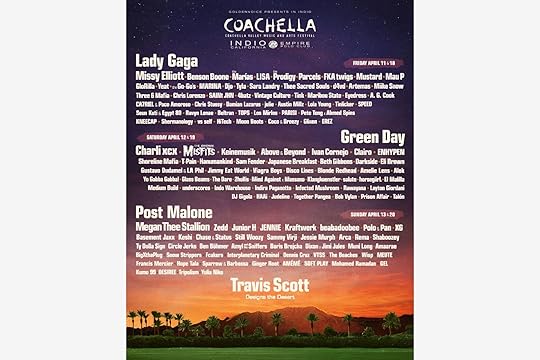
Held across two weekends in Indio, Coachella has grown to become a global music and arts powerhouse known for genre-spanning lineups and immersive art installations. The 2025 headliners include Lady Gaga, Green Day, Post Malone, and Travis Scott. Coachella is the place where music, fashion, and culture converge.
New Orleans Jazz & Heritage Festival

A sprawling cultural celebration featuring music, food, and local traditions at the New Orleans Fair Grounds Race Course, the 2025 lineup spans genres, from Pearl Jam and Luke Combs to Lil Wayne & The Roots and Burna Boy. It’s a soulful, eclectic experience that honors the city’s rich heritage.
Stagecoach Festival

As the country music counterpart to Coachella, Stagecoach lights up Indio, California with three days of twang and tunes. Headliners Zach Bryan, Jelly Roll, and Luke Combs bring star power to the desert. Expect line dancing, cowboy boots, and unforgettable performances.
RiverBeat Music Festival

RiverBeat takes over Tom Lee Park in Memphis with a diverse mix of pop, rock, and hip-hop. Headlined by Missy Elliott, The Killers, and Anderson .Paak & the Free Nationals, this new festival promises high energy by the river. It’s a fresh addition to Memphis’ rich musical legacy.
Lovin’ Life Music Fest
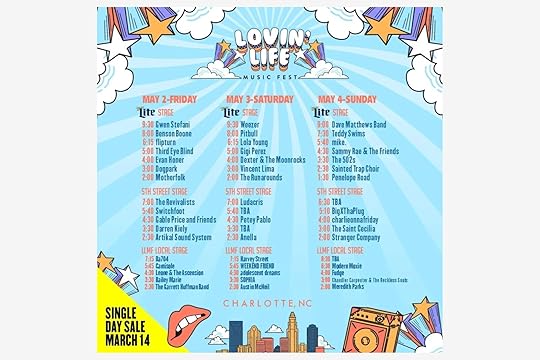
Charlotte’s First Ward Park hosts the Lovin’ Life Music Fest, a vibrant, feel-good weekend of eclectic performances. Headliners include Gwen Stefani, Weezer, Dave Matthews Band, and rising stars like Benson Boone and Teddy Swims. The festival delivers good vibes and great music for all ages.
Lone Star Smokeout

Set just outside AT&T Stadium, the Lone Star Smokeout pairs bold country acts with barbecue bliss. Jon Pardi, Cody Jinks, and Midland headline this Texas-style celebration. It’s where great food meets even better music in the South.
iHeartCountry Festival

Country music’s biggest names come to Austin for one electrifying night at the Moody Center. The 2025 lineup includes Brooks & Dunn, Thomas Rhett, Rascal Flatts, and more. It’s a powerhouse showcase of country hits and fan favorites.
BeachLife Festival
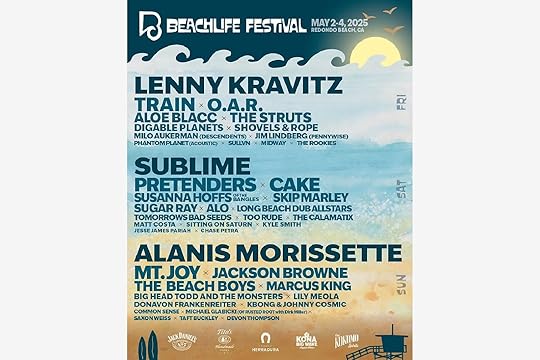
BeachLife Festival returns to Redondo Beach this year for a sun-soaked weekend of rock, reggae, and coastal vibes. Lenny Kravitz, Sublime, and Alanis Morissette top the bill in 2025. This beachfront celebration perfectly blends music and the laid-back surf lifestyle.
Sonic Temple Art & Music Festival

Crew Stadium will erupt with heavy rock energy during Sonic Temple. Korn, Metallica, and Linkin Park lead the 2025 lineup alongside other rock and metal giants that have defined the genre. It’s the ultimate gathering for fans of hard-hitting music and electrifying live shows.
Just Like Heaven Festival

A nostalgic nod to indie and alternative favorites in the iconic venue that is the Rose Bowl in LA. Vampire Weekend headlines this single-day celebration of beloved 2000s-era bands. Expect dreamy melodies, throwback energy, and a festival full of good vibes.
Kilby Block Party
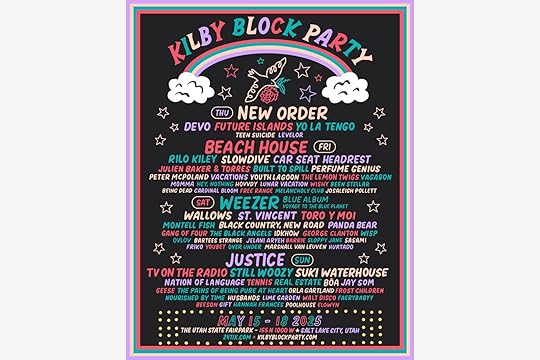
Salt Lake City’s Kilby Block Party brings indie, electronic, and alternative flair to Utah State Fairpark. The 2025 event features New Order, Beach House, Weezer, and Justice among others. The festival blends underground cool with big-name acts past and present.
Welcome to Rockville Festival
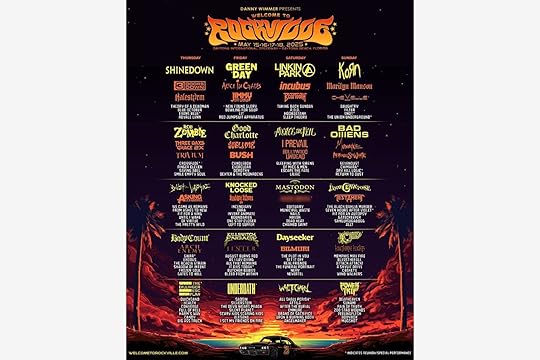
Welcome to Rockville takes over Daytona International Speedway in Florida for four days of pure rock adrenaline. This year’s lineup features Shinedown, Green Day, Linkin Park, and Korn. It’s one of the largest rock festivals in the US, packed with high-octane performances.
Electric Daisy Carnival

DC Las Vegas is an iconic, neon-drenched celebration of electronic dance music at the Las Vegas Motor Speedway. Afrojack, Tiësto, DJ Snake, and more bring pulsating energy to massive stages under the stars. It’s an unforgettable, immersive rave experience for EDM lovers.
Sand in My Boots Festival
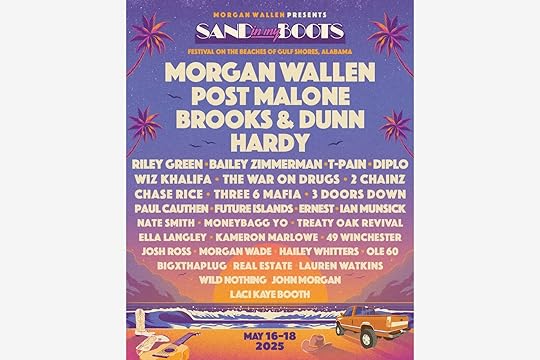
Held on the shores of Gulf Shores, Alabama, Sand in My Boots mixes country and mainstream appeal. Morgan Wallen, Post Malone, Brooks & Dunn, and HARDY headline the beachfront bash. It’s a laid-back, sun-drenched fest with major crossover vibes.
Wonderfront Music & Arts Festival
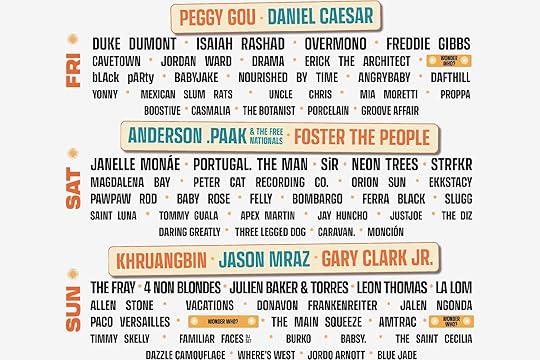
Downtown San Diego comes alive with Wonderfront, a multi-genre, multi-stage festival by the waterfront. The 2025 lineup features Peggy Gou, Anderson .Paak & the Free Nationals, Foster the People, and Jason Mraz. It’s a vibrant mix of music, art, and coastal charm.
Cruel World Festival

Cruel World Festival in Pasadena is a nostalgic dream for fans of post-punk and new wave. New Order and Nick Cave & the Bad Seeds headline this one-day event. The festival offers a stylish, retro escape with timeless sounds.
Boardwalk Rock Festival
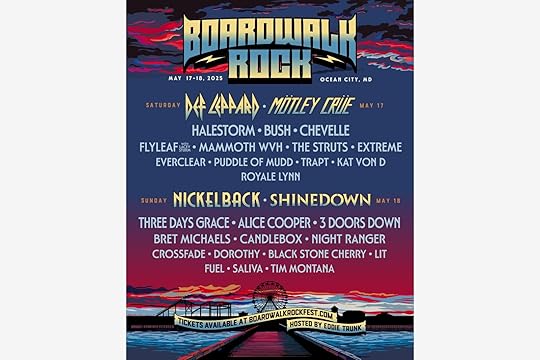
Ocean City’s Boardwalk Rock Festival delivers big riffs and louder energy on the East Coast shore. Headliners Def Leppard, Mötley Crüe, Nickelback, and Shinedown bring the heat. It’s a rock lover’s paradise right on the beach.
Boots in the Park Albuquerque

Boots in the Park heads to Albuquerque’s Balloon Fiesta Park for two days of country anthems. With Luke Combs and Cody Johnson as headliners, fans can expect hit after hit. It’s the perfect blend of Western flair and outdoor fun.
Boston Calling Music Festival

Boston Calling brings top-tier talent to Harvard Athletic Complex with a genre-blending lineup. Luke Combs, Fall Out Boy, and Dave Matthews Band headline the 2025 edition. The urban festival offers diverse music, food, and city vibes.
Gulf Coast Jam

Panama City Beach hosts Gulf Coast Jam, a beachfront country blowout with Blake Shelton, Tyler Childers, Lainey Wilson, and Sam Hunt. Set at Frank Brown Park, this fest combines sandy toes with honky-tonk spirit. It’s the ultimate Southern summer escape.
Railbird Music Festival

Railbird returns to Lexington at the scenic Infield at Red Mile with a laid-back yet powerful lineup. Lainey Wilson and Jelly Roll take top billing in 2025. The festival blends Southern charm, great music, and horse country vibes.
Roots Picnic

Philadelphia’s Roots Picnic is a soulful celebration of music and culture hosted by The Roots. The 2025 lineup features D’Angelo, Lenny Kravitz, and Meek Mill, with a strong focus on community and collaboration.
World Pride Music Festival: Global Dance Party

World Pride’s Global Dance Party in DC is a joyous, high-energy celebration of LGBTQ+ pride and music. Headliners Jennifer Lopez and Troye Sivan bring star power to the inclusive fest. It’s a dance-fueled weekend full of love, unity, and rhythm.
The Governors Ball Music Festival

New York City’s Governors Ball returns to Flushing Meadows Corona Park with a stacked lineup across pop, hip-hop, and indie. Tyler, the Creator, Olivia Rodrigo, and Hozier lead the 2025 bill. It’s a quintessential city festival with vibrant energy and skyline views.
Cali Vibes Festival

Cali Vibes brings reggae, hip-hop, and beach culture to Marina Green Park in Long Beach. With Stick Figure, Kid Cudi, and Rebelution on the bill, it’s a chilled-out weekend by the sea. This festival is all about good music and positive vibes.
Bonnaroo Music & Arts Festival

Bonnaroo transforms Great Stage Park in Manchester, Tennessee, into a four-day celebration of music, art, and community. The 2025 lineup includes Luke Combs, Tyler, the Creator, Olivia Rodrigo, and Hozier, with rumors that Kendrick Lamar and the Foo Fighters may join in. It’s a one-of-a-kind camping fest full of magical moments.
Summerfest

Milwaukee’s Summerfest spans three weekends with an unmatched variety of music at Henry Maier Festival Park. Def Leppard, Hozier, Megan Thee Stallion, and the Killers are just a few of the headliners. It’s one of the largest and longest-running music festivals in the world.
Mountain Jam

Set in the scenic Catskills of Highmount, New York, Mountain Jam offers a relaxed, jam-friendly music experience. Though headliners are yet to be announced, the festival traditionally features rock, folk, and Americana acts. It’s a perfect mountain getaway with a soulful soundtrack. 
The Nikon Z6 III Is the Most Underrated Hybrid Mirrorless Camera on the Market
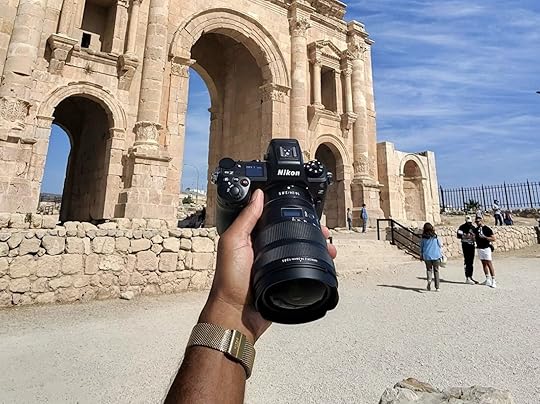
As a professional travel photographer I often get the question about what camera I’m currently using. Most people assume Sony because of YouTube virality or Canon because of name recognition, but it’s the other legacy brand that blew me away with its newest camera body. In 2024 Nikon released the Z6 III and I’ve had the opportunity to travel with this beast of a camera for the past few months on photo and video shoots around the world.
We hope you love the Nikon Z6 III! Just so you know, Matador may collect a small commission from the links on this page if you decide to make a purchase.

Photo: Rick Southers
The Nikon Z6 III is the third iteration of the Z6 series; Nikon’s entry point into the mirrorless camera space. This camera is made for the prosumer and it’s packed with features for photographers and video creators. As someone who has owned the first, second and now third versions of this camera, I was impressed by the recent leaps the newest model has taken. When I’m in the field shooting wildlife or dramatic landscapes, having the right tool for the job is essential to making sure I capture the moment.
What I appreciate most about this camera is the durability, speed, user interface, and bright LCD screen. These are just a few of the reasons I continue to choose this camera as my travel companion and why readers may want to give it a try themselves.
Nikon Z6 III design and build quality
Looking for a travel camera? Matador editors and writers review the best options: Matador editors broke travel photography down to five specific use cases. Here’s the best camera for each. This Affordable DSLR Is the Best Travel Camera for Stepping Up Your Photo Game The Sony Alpha ZV-E10 II Is the Do-It-All Compact Camera Made for Travel Creators Looking for a Travel Camera? The Sony A7 IV Is Worth the $2,500 Price Tag DJI Osmo Action 4 Review: A Lot of Tech in a Little Camera
The Nikon Z6 III is a full-frame mirrorless camera in a robust but compact body that’s perfect for travel. It’s a solid weather-sealed body that’s built for the elements and feels like a pro piece of equipment. The rubberized grip feels secure in the hand and the texture helps with keeping a firm hold while hiking or even in wet situations. Weighing in at 1.68 pounds, it’s still light enough for one hand operation when necessary. The fully-articulating 3.1” touchscreen further helps when shooting in unconventional positions and quickly changing settings.
Nikon Z6 III key features and specifications
Photos: Rick Southers
The full-frame sensor on the Nikon Z6 III ensures you’re able to capture as much of your scene as possible. In contrast, crop sensor cameras tend to be more affordable but also produce photos with a lower megapixel count. As someone who often shares photos in a variety of mediums, including print, it’s essential to my workflow to have high-resolution photos to work with. The 24-megapixel sensor on the Z6 III consistently delivers tack-sharp photos even with some modest cropping in post. With an ISO range up to 64000 I was able to capture some impressive night photography in almost total darkness –

Photos: Rick Southers
The autofocus system on this camera has made noticeable leaps between generations. The eye-detection autofocus for people (and animals) is fast and accurate with customizable modes for any scenario. It consistently finds my subject’s eye and even lets you switch between subjects, with a tap on the screen or click on the joystick. The subject tracking does struggle in crowded scenarios or when there isn’t enough contrast between the subject and the background, however it’s lightyears better than the original Z6. There is also some tweaking you can do in the settings menus to finetune its performance to your shooting style. See my Instagram for examples of how I’ve played around with this.
Another area where the Nikon Z6 III shines compared to its predecessors is video capabilities. The camera takes full-width 4K video at 60 frames per second with 10-bit color, which is very unusual for a camera in this price range. You can also record 4K video at 120 frames per second, but this uses a DX crop. The camera can even record 6K video at 60 frames per second, but only in N-RAW format, not in the more common ProRes RAW format. I’m hoping Adobe Premiere Pro and other editing software become more compatible with N-RAW in the near future. Nikon has even released some RED luts for color-grading that make for some beautiful footage.
Things I love about the Nikon Z6 III
Photo: Rick Southers
Versatility: The Z6iii is a true hybrid with pro photo features and serious video capabilities usually only seen in a true cinema camera. The new partially-stacked sensor allows up to 20 frames per second in RAW with autofocus enabled and up to 120 JPEGS per second.
Durability: The rugged weather-sealed body is built for the elements and has no issues with overheating or operating at freezing temps.Reliability: The Z6iii comes with 2 slots with one dedicated to CF Express Type B which is lightning fast. The other slot is a standard SD slot which is great for use as a backup or a jpeg specific card.Portability: For a relatively small mirrorless camera, the Z6iii is packed with features that otherwise would require a larger cinema rig.Image quality: The photos that come out of this 24 megapixel sensor are stunning straight out of camera with Nikon colors. I’m also able to capture beautiful handheld video footage because of the built in image stabilization.Price: At $2,200 this camera is a steal for pro photographers and filmmakers looking for an all in one solution or a hobbyist looking to upgrade from entry level to a more capable camera.Where there’s room for Improvement
Photo: Rick Southers
N-RAW: This video format allows for 6K RAW footage but currently has limited support
Sensor shield: I would love to see this feature on a Z6 level camera however it’s reserved for the high-end Z8 and Z9 bodies
In conclusion, the Nikon Z6 III stands as a compelling choice for both professional photographers and serious enthusiasts seeking a versatile, durable camera system. With its robust weather-sealed body, impressive autofocus capabilities, and exceptional video features at a competitive price point, this third-generation model represents significant advancement from its predecessors. While some limitations exist with the N-RAW format, the Z6iii’s combination of portability, reliability, and outstanding image quality makes it an exceptional value in today’s camera market and a worthy travel companion for capturing epic moments. 
March 21, 2025
Thailand May Halve the Length of Visa-Free Travel Amid ‘White Lotus’ Tourism Surge

Thailand is preparing to shorten its visa-free stay period from 60 days to 30 days for foreign tourists, just as a surge of travelers inspired by the hit third season of White Lotus has increased travel to the country. (Inspiration, it’s worth noting, that encourages lots of big spending.) The decision, agreed upon in principle by key authorities including the Tourism and Sports Ministry and the Foreign Ministry, according to euronews is aimed at addressing a surge in unauthorized employment and illegal business operations carried out under the guise of tourism.
The policy shift follows sustained pressure from domestic tourism operators and the Thai Hotels Association, both of which have voiced concerns about the unintended consequences of the extended 60-day allowance. While the policy was introduced in July 2024 to boost post-pandemic arrivals by expanding the exemption list to 93 countries, authorities say it has inadvertently facilitated illicit activities — from unauthorized work to unregulated short-term condominium rentals.
Check out Matador’s White Lotus-themed accommodations guides: 6 Affordable Wellness Retreats in Thailand for a ‘White Lotus’ Experience This Estate in ‘White Lotus’ Season 3 Is Available on Airbnb Book the Thai Beach Resort Where ‘The White Lotus’ Was Filmed Before It Sells Out Channel Your White Lotus Fantasy at These Thailand Airbnbs Stay in the Sicilian Hotel Where Season 2 of ‘White Lotus’ Was Filmed 6 Thailand Hotels that could be used for ‘The White Lotus’ Season 3The visa adjustment is just one component of a broader enforcement campaign. According to the Tourism and Sports Ministry, the Tourism Department will now apply stricter oversight under the Tourism Business and Tourist Guide Act. In 2024 alone, 40 tourism companies had their licenses revoked after authorities discovered unauthorized changes in company leadership structures, a tactic often used to conceal foreign-controlled enterprises operating under Thai nominee ownership.
A multi-agency task force has also been deployed in key destinations including Phuket and Pattaya, where it continues to investigate regulatory violations. The Thai Hotels Association has directly linked the extended stay period to a spike in unlicensed daily rentals of condominiums — a trend seen as undermining the formal hospitality sector.
While government officials acknowledge the possibility of a “small negative impact on inbound tourism demand,” the majority of short- and medium-haul travelers are unlikely to be affected. Industry data from ForwardKeys indicates that just 7 percent of bookings between January and February were for stays longer than 22 nights.
However, long-stay travelers — including digital nomads, remote workers, and retirees — may need to reassess their trips. Some industry voices have called for clearer provisions or alternative long-stay visa pathways to accommodate these groups without compromising immigration controls.
As of now, no official start date for the 30-day limit has been announced, and government sources have not yet confirmed whether transitional measures will apply to travelers with pre-booked extended stays, according to the Bangkok Post. Travel agents and prospective visitors are advised to monitor announcements from the Tourism Authority of Thailand and local consular offices in the coming weeks.
With a 2025 goal of welcoming over 40 million foreign visitors, Thailand continues to position itself as a premier destination in Asia. Yet the tightening of visa rules marks a recalibration — prioritizing systemic integrity over unchecked volume growth. Authorities say the reforms are essential to ensure fair competition, protect legitimate tourism operators, and safeguard Thailand’s long-term appeal in a competitive regional market. 
A Fire at Europe’s Biggest Airport Is Causing Thousands of Travel Disruptions Worldwide

A transformer fire at an electrical substation near Heathrow Airport triggered one of the most significant infrastructure failures in recent UK aviation history, shutting down the country’s busiest airport for a full day and affecting hundreds of thousands of travelers worldwide.
The fire broke out just before midnight on Thursday, March 20, in Hayes, west London. According to the London Fire Brigade, the blaze involved a transformer containing 25,000 litres of cooling fluid, and rapidly escalated into a critical incident. Energy Secretary Ed Miliband described it as “an unprecedented event,” according to the BBC, noting that the fire disabled both a substation and a back-up generator.
By midday Friday, Heathrow’s terminals remained closed to both arrivals and departures, with more than 1,300 flights affected and approximately 145,000 passengers stranded. At least 120 in-air diversions were reported, with flights rerouted to airports in Paris, Frankfurt, Brussels, Helsinki, and as far afield as Reykjavik. Other planes were forced to return to their departure points mid-flight.
Heathrow, which nearly 80 million passengers passed through in 2023, serves as a vital global transit hub. The abrupt cessation of operations had ripple effects across the aviation ecosystem. Airlines scrambled to reroute aircraft and launch “rescue flights,” while alternate airports — Gatwick, Stansted, and Dublin — reported cascading delays and cancellations. Ryanair introduced emergency services between Dublin and London Stansted to accommodate displaced travelers.
Although counter-terrorism police are leading the investigation, authorities emphasize there is no current indication of foul play. Still, the severity of the incident has sparked renewed scrutiny over the resilience of the UK’s critical infrastructure. The backup systems, while operating as designed, were not created to power the entire airport.
Industry analysts estimate the shutdown could cost the aviation sector more than £20 million (nearly $26 million) per day. Locally, the fire left 16,000 homes without electricity and prompted criticism over delayed communication with residents.
By Friday evening, Heathrow began a phased resumption of limited operations, with British Airways authorized to launch a small number of outbound long-haul flights. Full service is expected to resume by Saturday, according to airport officials. The government has temporarily lifted overnight flight restrictions to ease the congestion, and train operators are honoring flexible ticketing for affected travelers.
Affected travelers are encouraged to contact airlines directly for compensation on canceled or heavily delayed flights (yes, even non-refundable tickets are eligible). Those with travel insurance may be able to have hotels and reservations that can’t be completed reimbursed as well. 
The Best Beachfront Airbnbs in Waikiki for Access to Everything

Waikiki is the perfect place to base yourself for a vacation in Hawaii. Located on the south shore of Oahu, Waikiki is home to two miles of dazzling coastline, endless shopping, dining opportunities, world class accommodation and postcard-worthy views. There are plenty of activities to keep you busy. You can enjoy award-winning restaurants, or simply relax on one of the six beaches that make up this famous stretch of Hawaii. With its close proximity to Honolulu city center and easy access via the Waikiki Trolley, it’s also easy to explore all that Oahu has to offer without having to travel far from your Airbnb Waikiki rental.
Although famed for its resort hotels, staying in a Waikiki Airbnb often works out more comfortable (not to mention, affordable). Vacation condos have kitchens and additional living space which is especially suitable for families or travelers who prefer to cook some meals at home. Check-in is faster when you’re not dealing with crowded lobbies and in place of resort fees you may find an attractive discount when booking for a week or longer. Some rentals in Waikiki are found on the premises of hotels which means they come with such resort perks as pool access and secure parking. However, it’s important to check the terms before reserving a place.
Last but not least, Airbnbs in Waikiki have stunning ocean and Diamond Head views that match those of any hotel. Properties range from modern clean studios with full kitchens, ideal for a couple, to luxury condos for groups overlooking the sand. These are the top rentals in Waikiki with easy access to the coast.
Traveling to Hawaii? Check out Matador’s accommodation guides to Hawaii:The Best Airbnbs on Hawaii’s Big Island, From Beachside Villas To a Downtown CottageThe Coolest Airbnbs on Oahu, Hawaii14 Stunning Kauai Airbnbs That Are Actually Affordable9 of the Most Breathtaking Airbnbs on Maui
We hope you love the Airbnb Waikiki rentals we recommend! Just so you know, Matador may collect a small commission from the links on this page if you decide to book a stay. Listed prices are accurate as of the time of publication.
Luxury oceanfront apartment
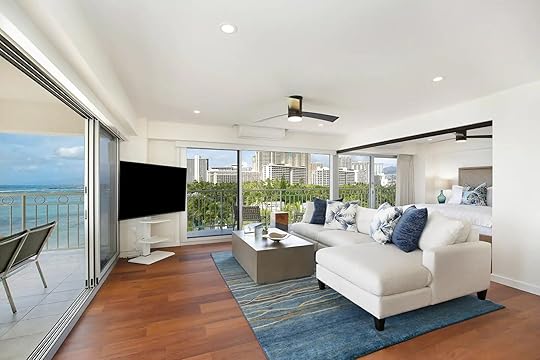 Photo: Airbnb
Photo: Airbnb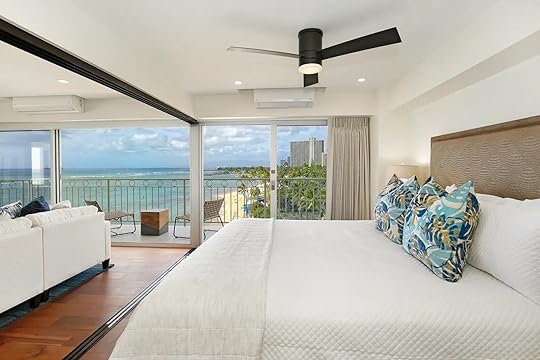 Photo: Airbnb
Photo: Airbnb Photo: Airbnb
Photo: AirbnbRecently renovated, this apartment is a great fit for a couple, group, or family. The beachfront unit looks over the Waikiki shoreline, offering panoramic views within a coastal-themed high-class resort. Two spacious lanais (balconies) offer outdoor space for wildlife spotting or an evening sundowner. Although there is no on-site pool, the condo is minutes away from Waikiki Beach and the main promenade. Floor-to-ceiling glass doors open out from the living area, which makes the open-planning layout feel expansive. It’s one of the top Airbnb Waikiki rentals for those who prefer the amenities and safety of a resort (without resort fees), love to cook, and like the comfort of a hotel without the stuffiness.
Six guests, two bedrooms
Price: $1,389 per night
 Photo: Airbnb
Photo: Airbnb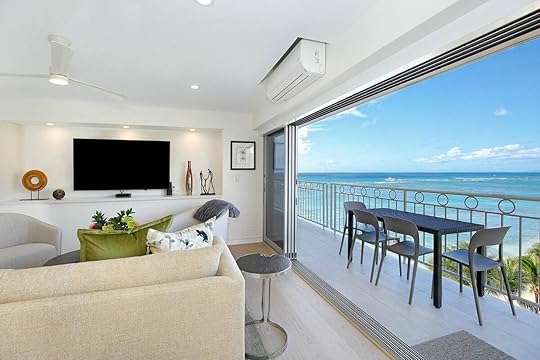 Photo: Airbnb
Photo: Airbnb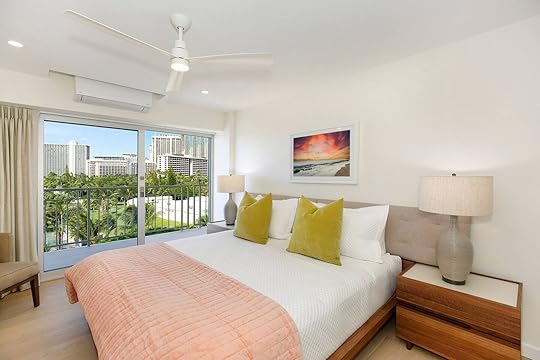 Photo: Airbnb
Photo: AirbnbThis condo is another great option for a group or family who’d prefer to have a home base where they can come and go close to the beach. It’s a level down from the rental above, but the price point does not diminish from its luxurious touches. The contemporary lanai is roomy with outdoor seating and an epic view over Waikiki. The open-planned living area has a smart TV, a pull-out couch (ideal for two small children or one adult), and the custom kitchen comes with stainless steel appliances, a kitchen island, and a sprawling view over the ocean. A rainfall massage shower, a dual vanity with quartz countertops elevate the en-suite, and there is a second bathroom with a bathtub shower combo. To top it off, there’s free parking for one vehicle within the resort and access to on-site amenities.
Six guests, two bedrooms
Price: $899 per night
 Photo: Airbnb
Photo: Airbnb Photo: Airbnb
Photo: Airbnb Photo: Airbnb
Photo: AirbnbSituated on the mezzanine floor with a semi-private entrance, this stylish two-bedroom condo is another superb option for a family or group. It has a large covered outdoor patio, access to a swimming pool, and a on-site gym. It’s not a beachfront property, but that shouldn’t deter you, its location is peaceful, and with extra space on the lanai and garden area, there’s plenty of room for kids to safely roam. The beach is an easy, breezy ten-minute walk and Fort DeRussy Park — an expanse of white-sand beach, with children’s playgrounds, exercise equipment, grills, tables, pickleball and racquetball courts — is next door.
Eight guests, two bedrooms
Price: $755 per night
 Photo: Airbnb
Photo: Airbnb Photo: Airbnb
Photo: Airbnb Photo: Airbnb
Photo: AirbnbWith epic views and a chic and contemporary interior, this is the pad you want to book for a weekend away with adult friends. With notes of traditional Hawaiian design blended with a bold primary color palate, the rental is unapologetically striking. The two-bedroom suites have king-sized beds topped with crisp Egyptian cotton lines, luxury towels, and modern touches such as USB charging ports and Bluetooth speaker radios. The lanai has black-out shades, but it’s doubtful you’d want to utilize those, as this is hands down one of the best Airbnb Waikiki rentals for sunrise and sunset. It has everything you need and more, a fully kitted-out chef’s kitchen, safety within a resort complex, smart TVs, and beautiful customized quartz counter topped bathrooms.
Six guests, two bedrooms
Price: $700 per night
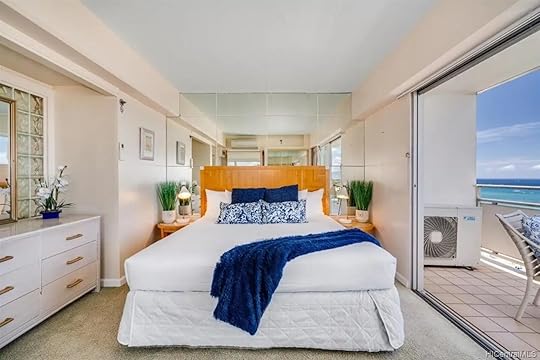 Photo: Airbnb
Photo: Airbnb Photo: Airbnb
Photo: Airbnb Photo: Airbnb
Photo: AirbnbWaikiki Beach, lagoon, and marina are steps outside the lobby of this two-bedroom corner unit rental. In the heart of the action, this is a superb option for those looking to enjoy the nightlife of Waikiki without having to consider driving or taking a ride-share. The apartment grants access to a shared pool and the huge balcony comes with ample outdoor seating, perfect for a sundowner or evening meal. Its unobstructed view is the major selling point, but the Airbnb is also very well equipt with everything your group would need and the rate per night is very reasonable. Considering the cost of accommodation in Hawaii, this unit is a steal for those wanting to be in central Waikiki.
Seven guests, two bedrooms
Price: $649 per night
 Photo: Airbnb
Photo: Airbnb Photo: Airbnb
Photo: Airbnb Photo: Airbnb
Photo: AirbnbThis listing markets towards families and groups, but considering its stylish bright, modern interior — white couches and curtains and marble top counters — it is perhaps better suited for an adult weekend away such as a bachelor or bachelorette party. The layout is unique to the area, rather than being open-planned, the rooms offer guests privacy and lots of space to relax in peace or come together on the outdoor patio. It sleeps nine, with two sleeper sofas in the communal living area, a twin bedroom, and a king-sized room. There are two separate bathrooms with state-of-the-art technology such as LED backlit mirrors and walk-in showers. The owners also supply guests with beach gear, which is a nice added bonus and rare to find with other Waikiki Airbnb rentals.
Nine guests, two bedrooms
Price: $612 per night
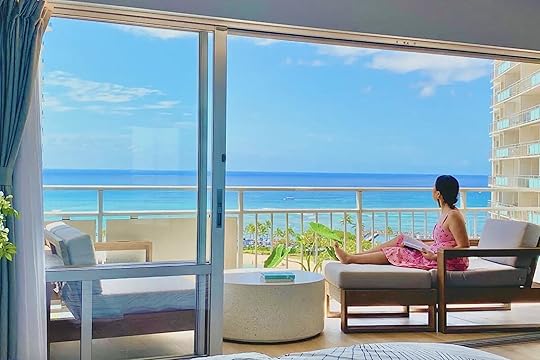 Photo: Airbnb
Photo: Airbnb Photo: Airbnb
Photo: Airbnb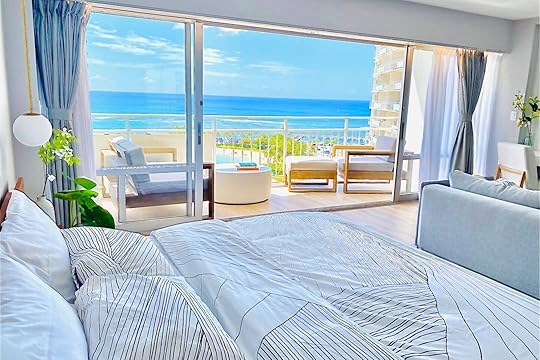 Photo: Airbnb
Photo: AirbnbThis open-planned, light-filled Airbnb is the best option for a couple on the beachfront. It has direct views over Waikiki from its floor-to-ceiling wall of windows that open up onto a small lanai. The balcony features an outdoor sofa (perfect for afternoon naps) and a lounge chair where you can watch the surfers dive through the ocean waves. There are two swimming pools within the resort making this Airbnb feel more like a hotel with the bonus of a private kitchen and homely ambiance.
Four guests, one bedroom
Price: $399 per night
 Photo: Airbnb
Photo: Airbnb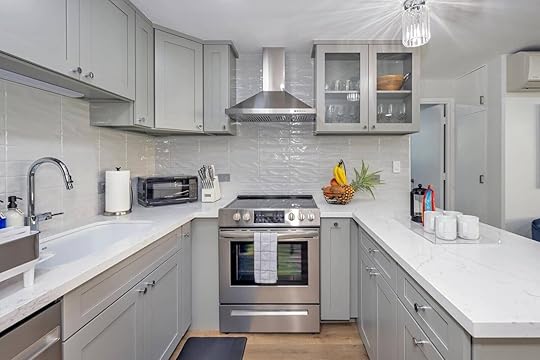 Photo: Airbnb
Photo: Airbnb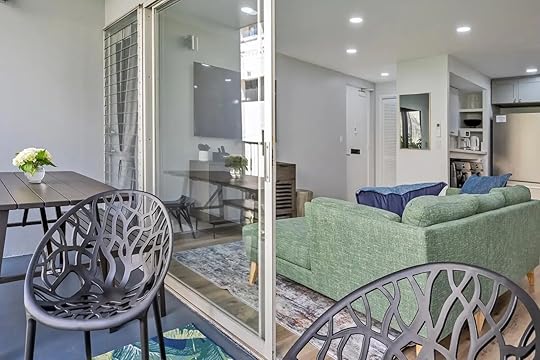 Photo: Airbnb
Photo: AirbnbThis two-bedroom condo is an affordable option and caters to all — families, remote workers, and groups of friends. It’s a superb option for those looking for a longer stay in the area as it’s well-organized with beach gear and high-speed WiFi and a dedicated workspace. It also has free parking and is close to a handy grocery store and other shops and restaurants. Yes, it’s not prime real estate on the beach, but it’s a bargain, and an easy journey to the ocean with the convenience of being next to city amenities. 
Six guests, two bedrooms
Price: $375 per night
 Photo: Airbnb
Photo: Airbnb Photo: Airbnb
Photo: Airbnb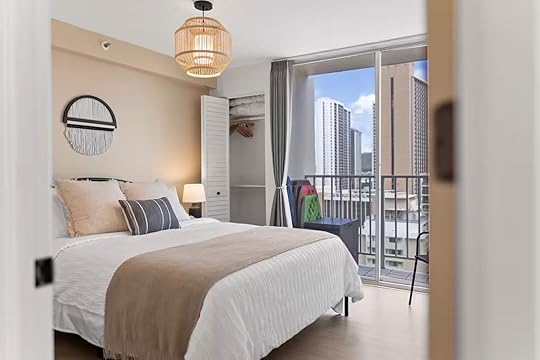 Photo: Airbnb
Photo: Airbnb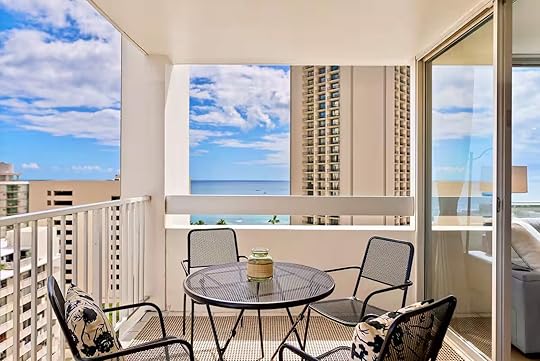 Photo: Airbnb
Photo: AirbnbSee more photosNo hotel room can compete with this Guest Favorite Airbnb in Waikiki. The unit has a chic living space with a kitchen stocked with gizmos, stylish crockery, and cooking essentials. There are two balconies plus a selection of beach toys and boogie boards. The building is topped by the highest rooftop terrace and pool in this part of Honolulu. There are also shared grills and a games den to enhance the experience.
Four guests, one bedroom
Price: $304 per night
 Photo: Airbnb
Photo: Airbnb Photo: Airbnb
Photo: Airbnb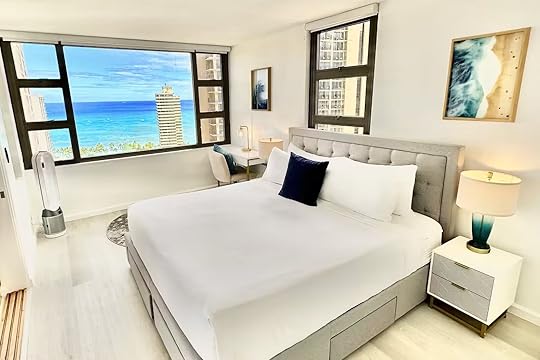 Photo: Airbnb
Photo: Airbnb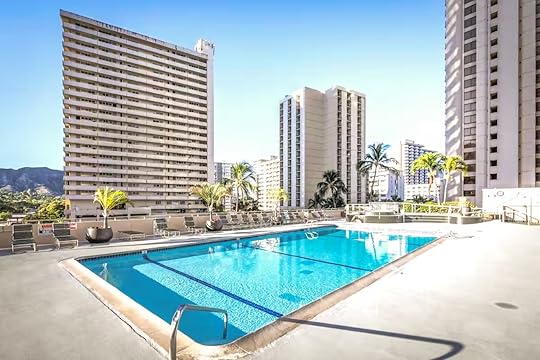 Photo: Airbnb
Photo: AirbnbSee more photosThis upscale vacation condo is located at the south end of Waikiki Beach near Diamond Head. It has one hotel-quality bedroom plus additional sleeping space on the couch. Besides a high-tech kitchen, you’ll find a medley of beach gear, yoga equipment, and a mini tiki bar for all leisure needs. There’s also a shared pool on the complex and laundry facilities on each level. If you tire of ocean waves, there’s a state-of-the-art Marshall system for connecting your travel playlist.
Four guests, one bedroom
Price: $416 per night
 Photo: Airbnb
Photo: Airbnb Photo: Airbnb
Photo: Airbnb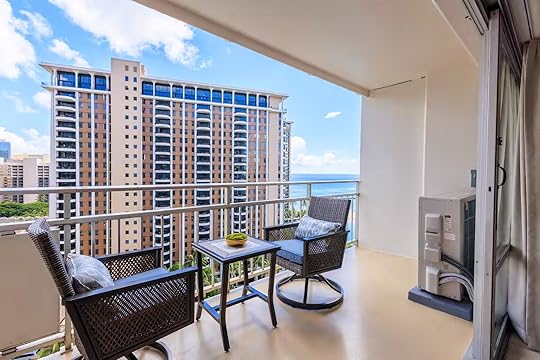 Photo: Airbnb
Photo: Airbnb Photo: Airbnb
Photo: AirbnbSee more photosPart of the Ilikai Hotel complex, this Guest Favorite Airbnb gives you a fusion of both accommodation types and includes one free parking space. It’s designed for a couple, although additional guests – kids, ideally – can sleep on the sofa bed. Located at the northern end of Waikiki, you’ll enjoy beautiful views of the Pacific Ocean and the weekly fireworks show over the Duke Kahanamoku Lagoon from the lanai.
Four guests, one bedroom (studio)
Price: $287 per night
 Photo: Airbnb
Photo: Airbnb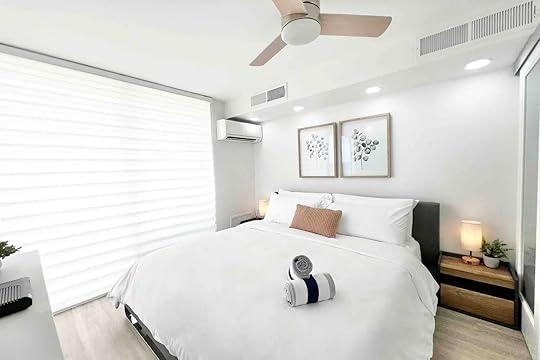 Photo: Airbnb
Photo: Airbnb Photo: Airbnb
Photo: Airbnb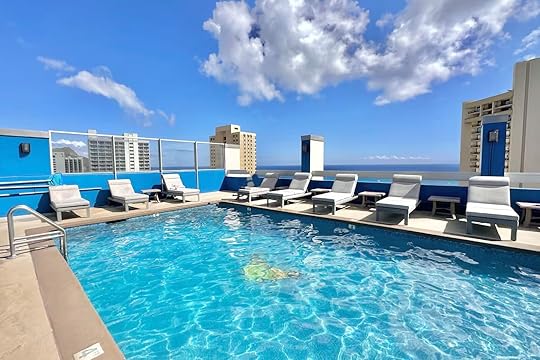 Photo: Airbnb
Photo: AirbnbSee more photosYou’ll need a head for heights while staying at this baller Waikiki Airbnb on the 32nd floor. A vast open-concept living space is well-matched by expansive ocean, city, and mountain views. Air-conditioning and in-unit laundry facilities make for a stress-free stay. Beyond the apartment, you’ll find a communal pool, hot tub, sauna, and lawn games on the rooftop. Parking is available at a reasonable cost and the beach is a three-minute walk.
Four guests, one bedroom
Price: $338 per night
 Photo: Airbnb
Photo: Airbnb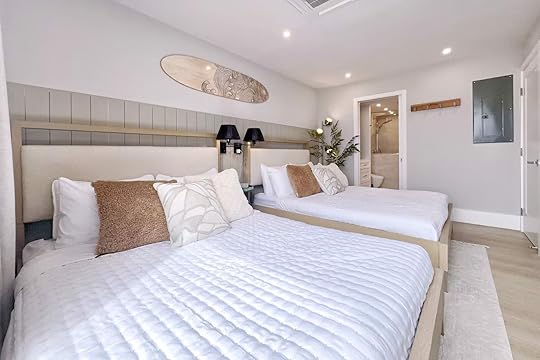 Photo: Airbnb
Photo: Airbnb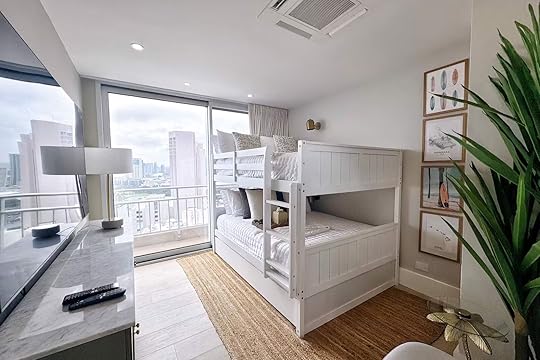 Photo: Airbnb
Photo: Airbnb Photo: Airbnb
Photo: AirbnbSee more photosA slightly more extravagant option in Waikiki’s luxurious oceanfront hotel, this two-bedroom apartment sits on the 26th floor and presents unparalleled views. The open-plan living room and kitchen flow onto a lovely lanai with seating. One bed has two queen beds whereas the other has bunks, making this a top contender for families and small groups alike. The rental includes one free parking space.
Six guests, two bedrooms
Price: $997 per night
 Photo: Airbnb
Photo: Airbnb Photo: Airbnb
Photo: Airbnb Photo: Airbnb
Photo: Airbnb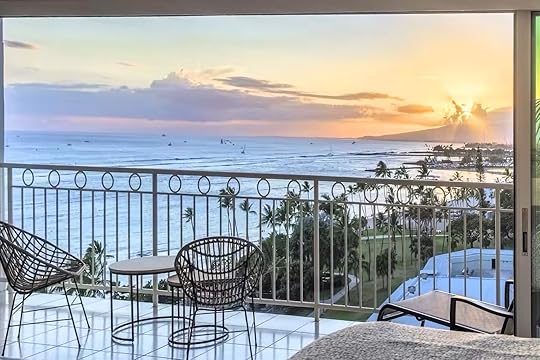 Photo: Airbnb
Photo: AirbnbSee more photosThis roomy studio for couples has a private balcony overlooking the ocean, a bathroom with a tub, and in-unit laundry facilities. There’s also a Bluetooth sound system to let you design a personalized soundtrack for sunset. Although part of the Waikiki Shore Hotel, the Airbnb is managed independently and you’ll be looked after by an experienced Superhost throughout your stay.
Four guests, one bedroom (studio)
Price: $420 per night
 Photo: Airbnb
Photo: Airbnb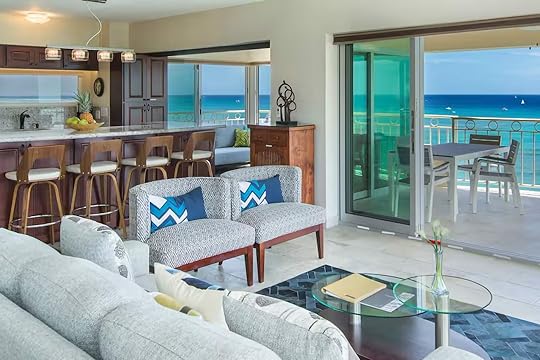 Photo: Airbnb
Photo: Airbnb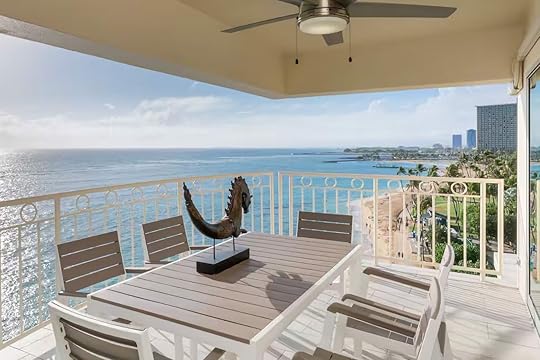 Photo: Airbnb
Photo: Airbnb Photo: Airbnb
Photo: AirbnbSee more photosThis three-bedroom apartment can accommodate up to eight guests plus two additional infants and provides a cozy refuge for families. A sweeping lanai offers panoramic views across the golden sand and twinkling ocean. The corner tub is handy for those traveling with toddlers while the in-unit washing machine takes the pressure off packing. All this, and just minutes from the best beach in Honolulu!
Eight guests, three bedrooms
Price: $1,706 per night
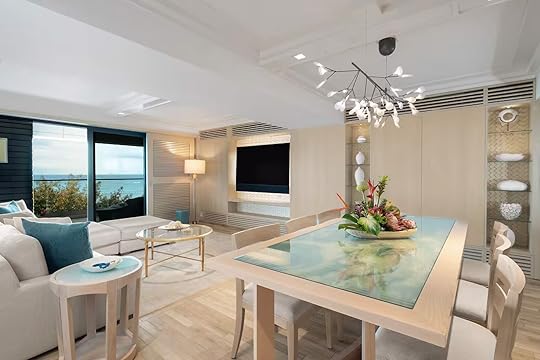 Photo: Airbnb
Photo: Airbnb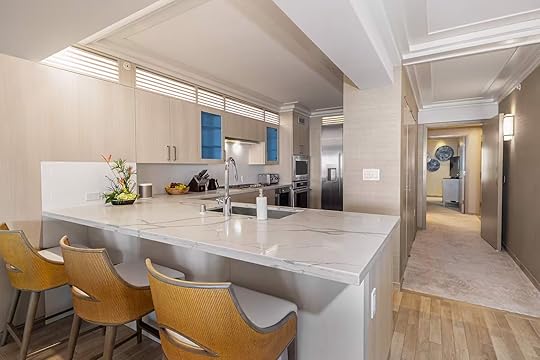 Photo: Airbnb
Photo: Airbnb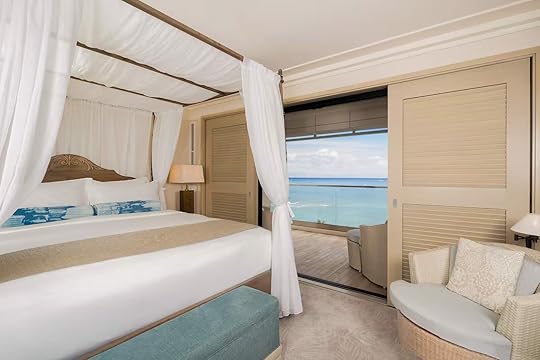 Photo: Airbnb
Photo: Airbnb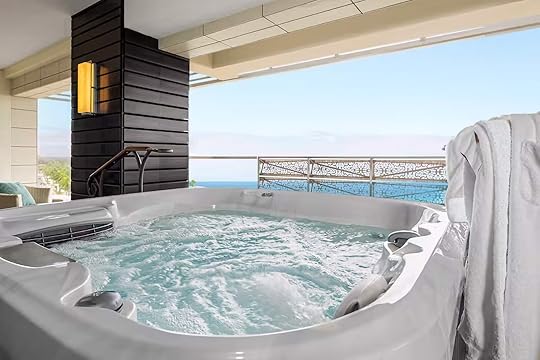 Photo: Airbnb
Photo: AirbnbSee more photosIt’s a splurge but this Luxe Airbnb in Waikiki is worth every last cent! Both bedrooms have an en suite bathroom plus direct access to the lanai with ocean views. Besides the sociable marble-top kitchen and lounge, the apartment has a private hot tub and sauna. You’ll have access to the communal rooftop and shared pool. Kapiolani Park and Diamond Head are on the doorstep.
Six guests, two bedrooms
Price: $10,000 per night
 Photo: Airbnb
Photo: Airbnb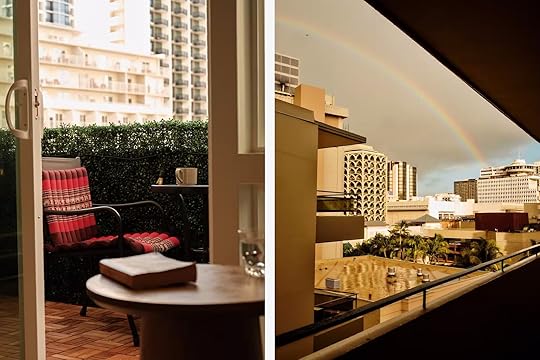 Photo: Airbnb
Photo: Airbnb Photo: Airbnb
Photo: AirbnbSee more photosThis sophisticated Airbnb is minutes from Waikiki’s best beaches and no car is needed. The decor focuses on a pristine subway tiled kitchen and bathroom with lots of wood finishes to add an earthy layer unusual for Honolulu. The apartment has a small balcony ideal for breakfasting and evening wine. Waikiki Beach is a three-minute walk while restaurants and grocery stores are even closer.
Two guests, one bedroom
Price: $212 per night
 Photo: Airbnb
Photo: Airbnb Photo: Airbnb
Photo: Airbnb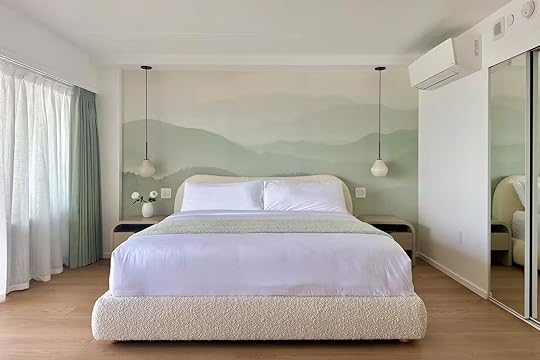 Photo: Airbnb
Photo: Airbnb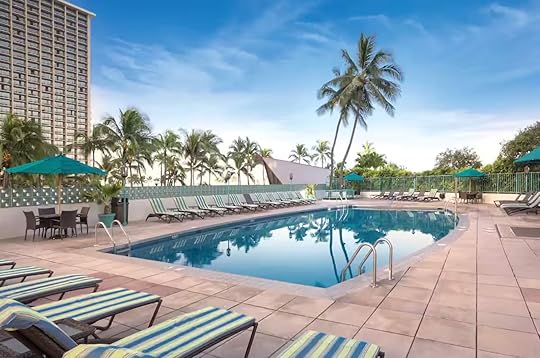 Photo: Airbnb
Photo: AirbnbSee more photosThis contemporary vacation apartment stuns with its harbor views and proximity to the beach. The lounge opens out onto a spacious balcony where you might catch sight of the resident dolphin pod. If not, the sunsets are priceless. The unit is nicely outfitted for self-catering with a coffee maker and juice blender rounding off a well-stocked kitchen. There is also a cafe and restaurant on site.
Four guests, one bedroom
Price: $252 per night
Expert Approved: How to Pick Your Next Scuba Dive Vacation Destination
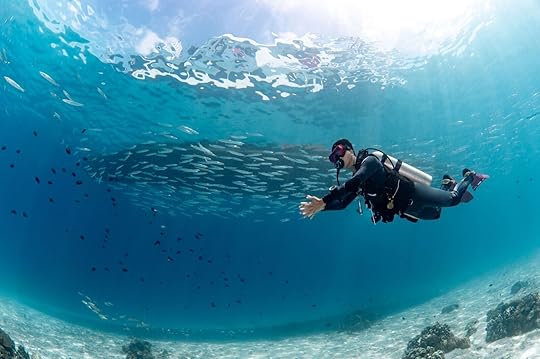
Becoming a capable scuba diver isn’t as complicated as you may think — but if you’ve ever heard certified scuba divers talk among themselves, you’d be forgiven for thinking you had to learn a whole new language just to know what they’re talking about. All it takes is a minute or two of divers name-dropping sites and shops, debating about the average “vis” or talking about “muck” and “nudibranchs” before your head starts spinning.
That can make planning your first dive-focused trip a little intimidating, especially if you’re doing the planning based on dive forums, websites, and trip reports that can go into an overwhelming amount of detail. How are you supposed to know if you should prioritize water temperature or clarity? What does an “easy” dive mean? And is there a certain time of year you should visit a dive site? Or are some dive destinations good year round? Which are which?
Fortunately, there are plenty of experts out there who can not only help, but genuinely want to. That includes dive organizations like PADI (Professional Association of Diving Instructors), SSI (Scuba Schools International), NAUI (National Association of Underwater Instructors), SDI (Scuba Diving International), and TDI (Technical Diving International), to name just a few. Those are all for-profit organizations, so it behooves them to make planning dive trips and entering the world of scuba diving as easy as possible. While certified divers often like to nerd out on tech (and sometimes one-up each other on who has been to the most remote dive locations), dive professionals themselves tend to be much more approachable and very used to assisting beginners.
With 6,600 dive centers and resorts in more than 180 countries, PADI is by far the largest and most well-known certifying body in the world. More than 70 percent of recreational divers are certified by PADI, and it has issued a collective 29 million diving-related certifications since its founding in 1966. So we asked Kristin Valette Wirth, PADI’s Chief Brand and Membership Officer, for some insight on how to make one of the biggest decisions of any dive trip: where to go and when.
This interview has been edited for length and clarity.
Matador: What factors go into deciding the best month to dive in a given location?
For cold-water diving, as with orcas in Norway, you’ll likely need a dry suit certification to rent a dry suit, if you don’t have your own. Photo: Willyam Bradberry/Shutterstock
KVW: Changing seasons and animal migrations are two factors that can impact the best time for most people to scuba dive. While warm water is always nice to scuba dive in, cold water and ice diving are equally amazing. You can have the chance to encounter orcas while diving in New Zealand and Norway, or take part in the world-famous sardine run in South Africa. Then there is ice diving in Japan, where at the start of each year you can dive Shiretoko Peninsula — a UNESCO World Heritage Site — when the sea ice is just beginning to break up and ice floes appear off the coast of the peninsula and cute little cliones, or sea angels, are flittering about.
Matador: What are a few of your favorite dive sites around the world?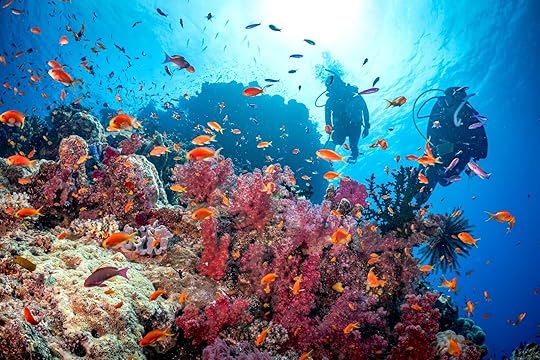
Rainbow Reef, Fiji., Photo: PADI
KVW: Rainbow Reef, Fiji. I was lucky enough to dive there recently on a family holiday. The soft coral there is as if a rainbow exploded and is a symbol of hope for the ocean. This year, PADI is working with local governments in Fiji to make Rainbow Reef an official MPA (Marine Protected Area).
Also Casino Point, Catalina Island. It’s just a short ferry ride from Southern California, there is an abundance of marine life to encounter. Aside from the expansive kelp forest, divers will find horn sharks, sea urchins, spiny lobsters, sea cucumbers, seals and giant sea bass. This was also the dive site where I certified my daughter as a PADI Open Water Diver, making it forever a favorite dive site.
Matador: How does skill or certification level factor into deciding where to scuba dive?
Certain types of diving, like wreck diving, require additional certifications. Photo: Martin Voeller/Shutterstock
KVW: This is equally an important factor to consider, as your certification will determine what dive sites you are allowed to go. If you want to do wreck diving, night diving or drift diving you will want at least an Advanced Open Water (AOW) certification. And if you want to embark on a liveaboard trip, most operators require at least a minimum of 50 logged dives.
There are also very friendly learn-to-dive or beginner dive destinations year-round, such as the Caribbean islands, Spain, Greece, the Philippines, and Thailand.
Matador: Given that most dive sites have their strengths year-round, how much does seasonality even matter?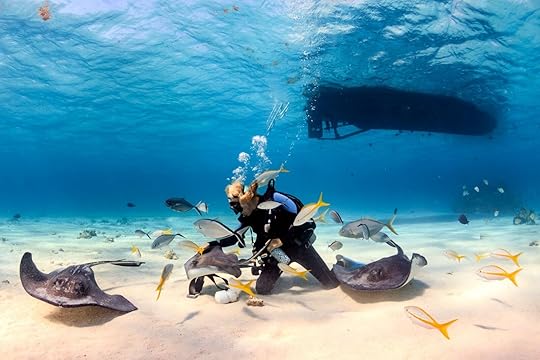
Diving in the less popular season at many destinations can mean less crowded dive boats and more space at top dive sites. Photo: Richard Whitcombe/Shutterstock
KVW: The ocean is unpredictable, and being underwater is always an incredible and life-changing experience. There is never a guarantee that scuba divers will encounter anything, making it all the more special when you get to witness something incredible beneath the surface. You can also make every dive have a deeper purpose no matter what time of year, from taking part in Dive Against Debris and removing marine debris from the ocean to taking part in coral reef survey checks to monitor their health. Every season of the year is a great time to seek adventure and save the ocean.
Matador: What are some destinations where you can only dive at a specific time of year? Or any specific phenomenon you can only see at a specific time of year?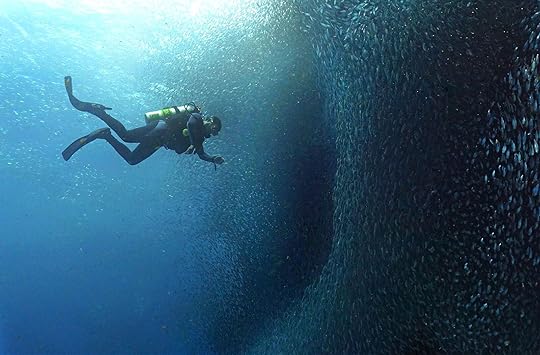
A diver approaching a massive school of sardines in an annual sardine run. Photo: frantisekhojdysz/Shutterstock
KVW: Magical moments are happening in the ocean every month of the year. This includes:
January: Hundreds of manatees migrate from the Gulf of Mexico to the warm springs of Crystal River, FloridaFebruary: Mexico’s Pacific Coast sees its peak whale-watching season during February where from the beach, boats, or even underwater, you might just witness sperm whales, humpback whales, gray whales with their young, or even the elusive blue whale.March: Mozambique in March is peak nesting season for five turtle species. Hundreds of females gather on sandy beaches, each laying over 100 eggs before the hatchlings bid for freedom about two months later.April: Gladden Spit in Placencia, Belize, is where whale sharks are drawn to when the eggs are released during the breeding season of two fishes (mutton snappers and groupers) provide a tasty feast for these passing pelagics.May: High concentrations of manta rays come into the Maldives during the shift to monsoon season and more plankton-rich watersJune: The annual famous Sardine Run in South Africa takes place, attracting pelagic lovers and adrenaline-loving divers to witness the kingdom of life underwater.July: Plankton blooms off the coast of Costa Rica attract huge schooling hammerhead sharksAugust: Thousands of migrating Australian giant cuttlefish come together to mate in a kaleidoscopic courtship display in the Upper Spencer [Gulf] Marine Park area of WhyallaSeptember: Calm conditions this month in Hawai’i bring the world-famous nightly symphony of manta rays that dance between divers in a magical underwater ballet performance.October: If you are heading down under, you’ll be able to witness the incredible phenomenon of coral spawning on the inshore reefs of the Great Barrier Reef. The inshore reefs usually start spawning between one and six nights after the first full moon in October.November: In Palau, you’ll be able to see parrotfish spawning for a few weeks of the month.December: Witness orcas, humpbacks, and the northern lights while embracing cold water and wreck diving in the fjords of Norway. More like thisDiving10 Pieces of Beginner Scuba Diving Gear for Your First Tropical Trip
More like thisDiving10 Pieces of Beginner Scuba Diving Gear for Your First Tropical Trip
March 20, 2025
How to Have the Best National Parks Trips This Summer, According to Experts

Summer national parks road trips are going to be different this year – while the parks remain as beautiful and worthy of exploration as ever, the recent staffing cuts in the National Parks Service put extra onus on park visitors to follow Leave No Trace principles in 2025. Nearly 332 million people visited national parks in 2024, and the parks are expecting numbers to rise in 2025. Collaborative stewardship is the only responsible way to visit national parks this year. Fortunately, guests have resources from the parks, the Leave No Trace organization, and Xanterra, which manages concessions, accommodations, and activities within the parks. Matador spoke with JD Tanner, Director of Education at Leave No Trace, and attended a webinar with Tanner and Todd Walton, Director of Marketing and Sales at Yellowstone National Park Lodges, operated by Xanterra, to learn how to put Leave No Trace principles in place to have the best experience at the national parks this summer.
For a successful summer, travelers must be aware of their impact
Photo: Andriana Syvanych /Shutterstock
Leave No Trace was formed in 1994 as a means to educate outdoor users on proper protocols. Leaving what you find and being responsible with campfires is applicable knowledge whether you’re near home or on the other side of the planet. The organization has marketed its work to and partnered with Destination Marketing Organizations (DMOs) as well as parks, conservation organizations, and elsewhere to help these groups develop their own guidelines for encouraging responsible tourism.
“Our Tourism Program’s expansion to over 60 Destination Management Organization partners in recent years has significantly amplified our educational outreach, promoting sustainable travel practices among a broader audience,” Tanner told Matador. “Many state and regional tourism offices are collaborating with us, developing stewardship-focused education and messaging campaigns to ensure that outdoor visitors have ample opportunities to learn about Leave No Trace.”
A recent example of this is Do Colorado Right, a program from the Colorado Tourism Office that seeks to educate travelers to the state on how to properly experience its great outdoors without being harmful. Pamphlets and signage is now posted throughout the state, including at national park gateway towns including Montrose, near Black Canyon of the Gunnison National Park and Estes Park, just outside Rocky Mountain National Park.
“It’s important to note that these collaborations have not only enhanced the visibility of Leave No Trace but also fostered a culture of environmental stewardship among travelers. By incorporating Leave No Trace education into tourism strategies, DMOs have empowered visitors to make responsible choices, reduce impacts on natural resources, and ensure the preservation of outdoor spaces.”
What is collaborative stewardship?
Photo: EWY Media/Shutterstock
A concept harked on repeatedly by both Tanner and Walton is collaborative stewardship. This refers to a cooperative approach where multiple stakeholders— government agencies, local communities, Indigenous groups, conservation organizations, recreation users, and private industry—work together to manage and protect public lands. Collaborative stewardship is more important than ever with staff reductions taking place in the parks at the same time visitation is at all-time highs.
Collaborative stewardship underlies the mission of Leave No Trace. It’s seven principles, from planning ahead to respecting wildlife and others in the outdoors to disposing of any waste, are designed to foster responsible use that ensures the longevity and health of public lands. Notably, Xanterra will implement a zero-emission battery powered locomotive at Grand Canyon in 2027.
“A common misunderstanding is the belief that the seven principles are strict rules instead of adaptable guidelines,” Tanner says. “This perspective can result in a limited application of Leave No Trace ethics, while the principles are intended to be flexible. They guide individuals in making informed decisions that reduce environmental impact in different situations. This misunderstanding may also cause DMOs to perceive incorporating Leave No Trace into their tourism language as a burden for their visitors. However, a report by Booking.com found that 76% of travelers are interested in learning about sustainable travel practices.”
An interesting statistic, Tanner notes, is that a person trained in LNT is five-times more likely to protect the outdoors than a person who isn’t, according to the organization’s data. Furthermore, that education tends to be conveyed to others while out enjoying open spaces.
Awareness can indeed prevent tragedy. 95 percent of wildfires are human-caused, for example, with Tanner noting during the webinar that it’s “not just campfires, but cigarette butts and other human-caused issues are causing those wildfires that we’re dealing with on a regular basis.”
Responsible public lands use starts with proper planning
Photo: Andriy Blokhin /Shutterstock
“A key mindset shift that needs to occur is recognizing that responsible recreation begins before reaching a destination,” LNT’s Tanner says. “Many people view Leave No Trace as actions taken while outdoors, but preparation—such as understanding a site’s rules and regulations, securing necessary permits, learning about local conservation issues, and packing the right supplies—plays a vital role in reducing negative impacts.”
When planning a trip to a national park, Xanterra’s Walton notes it’s good to book accommodations, camping, and tours ahead of time. This allows a chance to identify providers who are straightforward about their environmental impact. For stays and activities within the parks, Xanterra, for example, outlines its efforts on its website. It sources the majority of food from within 500 miles of the location, and is constantly increasing recycling and compost efforts across its portfolio.
It’s also a good idea to plan out hiking routes, campsites, and other activities in advance. This is the best way to set yourself up for success knowing there will be staff shortages. The same is true for dining and booking guided tours. Bring a “blue bag” when camping to dispose of human waste.
“Furthermore, utilizing technology, such as real-time trail updates, educational apps, and AI-driven trip planning tools, can assist outdoor enthusiasts in making informed choices,” Tanner says. “By cultivating a culture where planning is viewed as a core responsibility, outdoor users can more effectively minimize their footprint, protect public lands, and ensure these spaces remain accessible for future generations.”
What happens if a park closes?
Photo: Michael Vi/Shutterstock
Some 1,900 NPS staffers have already resigned with 1,000 fired, and rumors abound that some visitors’ centers may be closed this summer if further cuts follow. While the federal government narrowly averted a federal shutdown, the impact of staffing reductions hasn’t been realized yet. This could result in reduced camping availability, cancellation of activities like guided walks with rangers, and in some cases, even the shutdown of visitors’ centers. The parks themselves are expected to be open, however, and Walton noted that lodging in amenities where Xanterra operates — Yellowstone, Glacier, Grand Canyon, Rocky Mountain, Zion, Bryce Canyon, Death Valley, Petrified Forest, and Everglades National Parks — will operate at full capacity. Concessionaires at other national parks have not announced impacts, as of the date of publication.
Some parks themselves have already implemented changes:
Florissant Fossil Beds National Monument in Colorado is closed on Mondays and TuesdaysSaguaro National Park in Arizona has closed its visitor centers on MondaysYosemite National Park has postponed reservations for several campgroundsGrand Canyon National Park is experiencing longer wait times due to reduced staff at entrance stations“If there is a major closure we will reach out to all of our guests who have booked and be in communication with them,” Walton noted during the webinar. “As long as the gates are open, we will operate as normal.” 
Matador Network's Blog
- Matador Network's profile
- 6 followers



